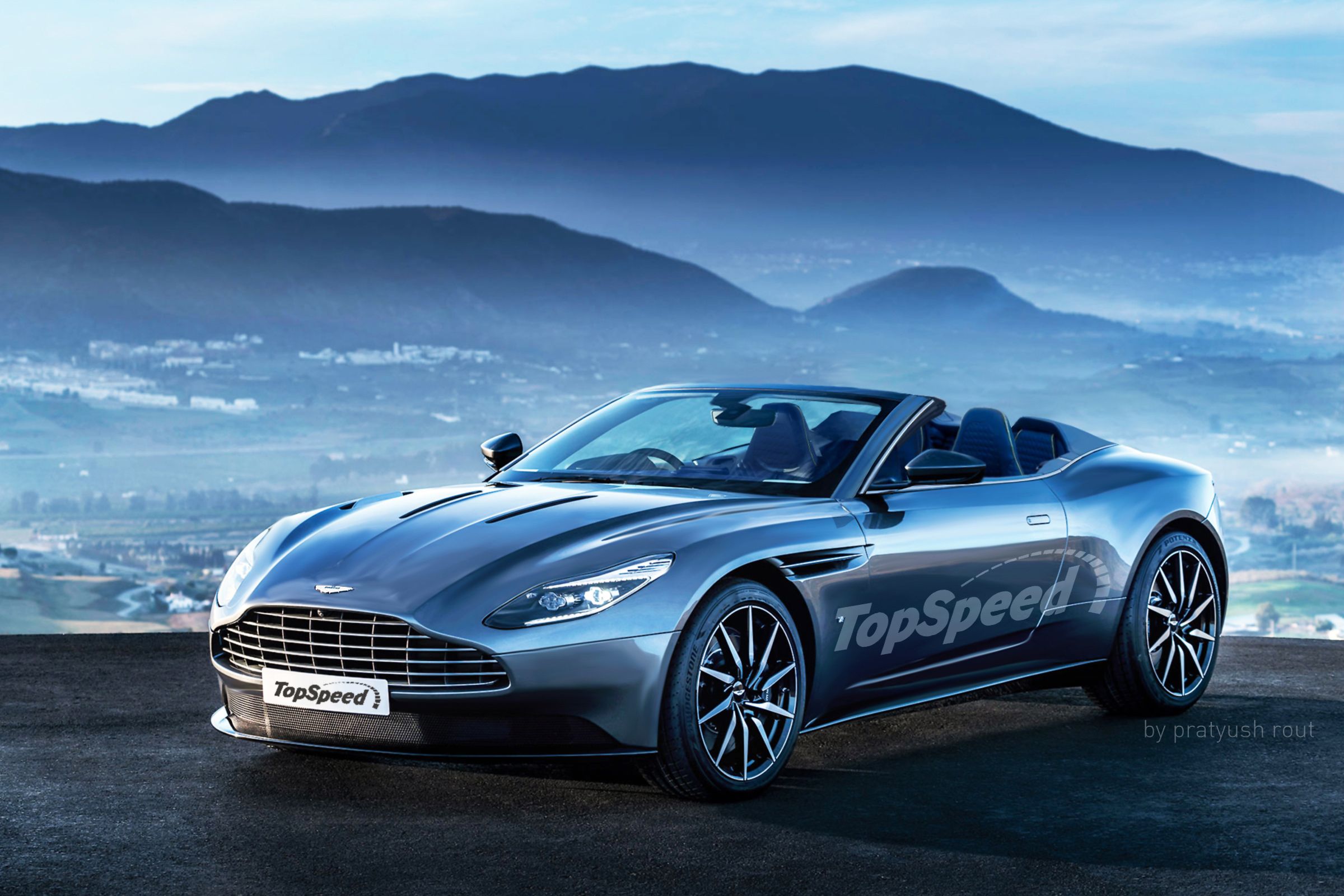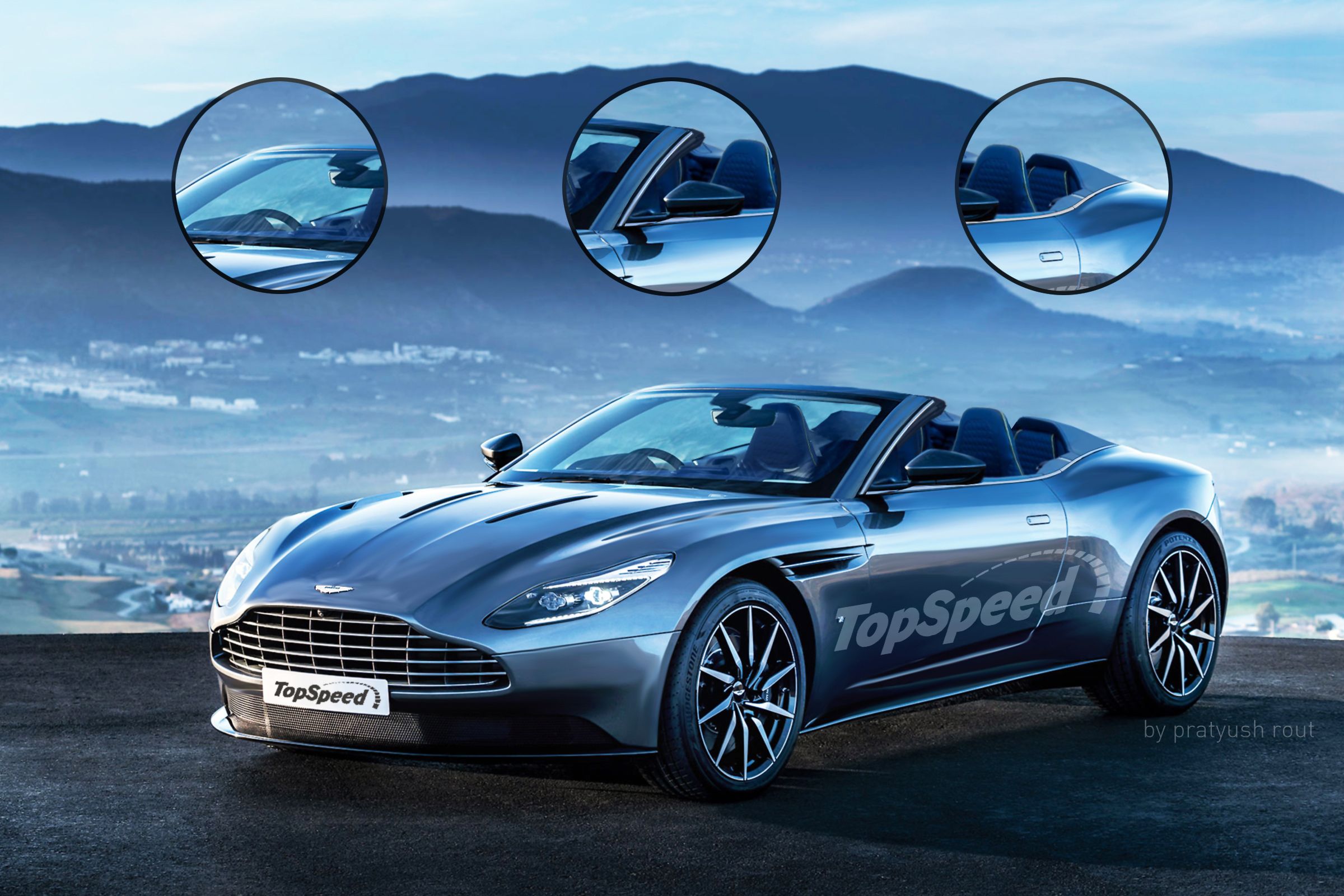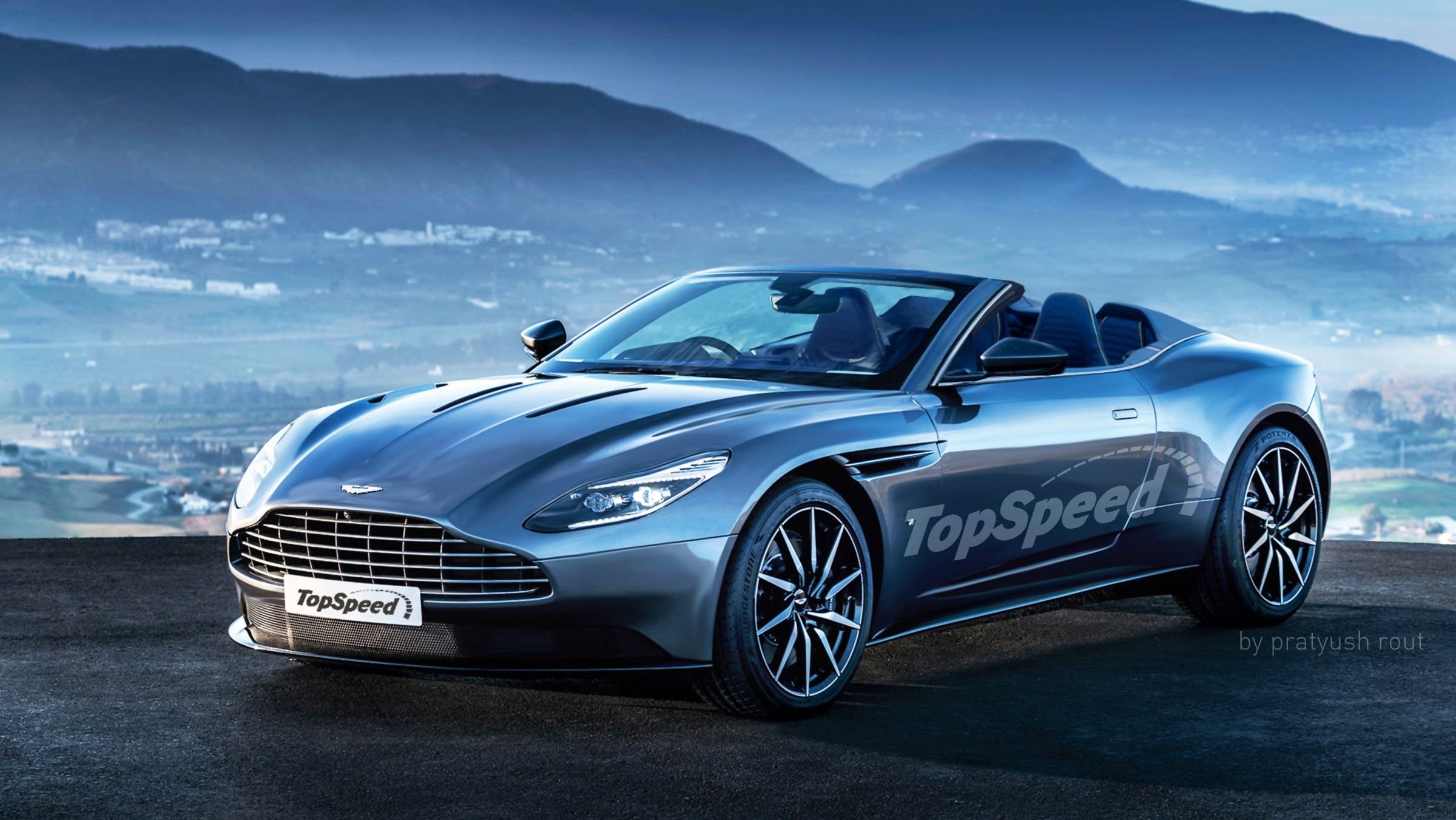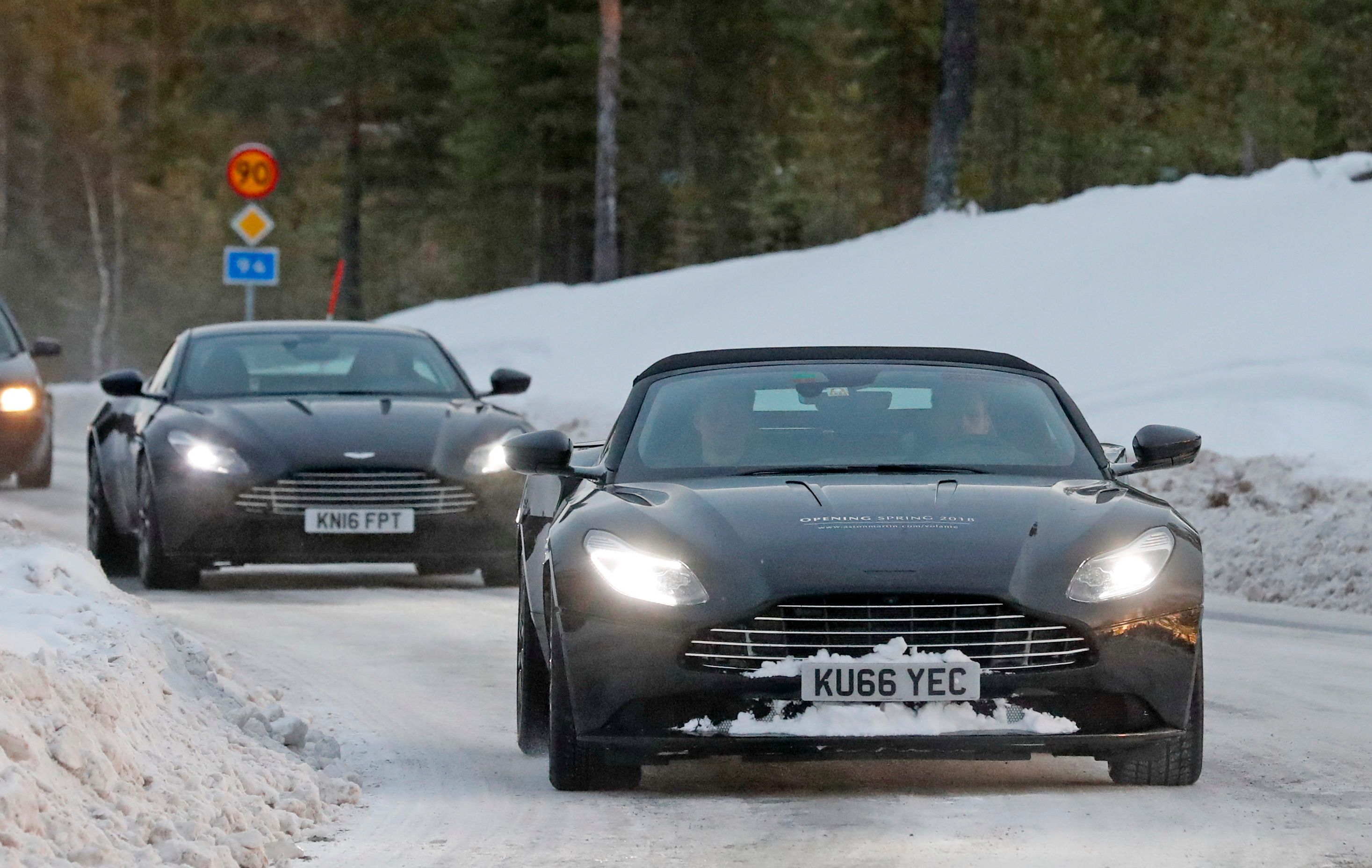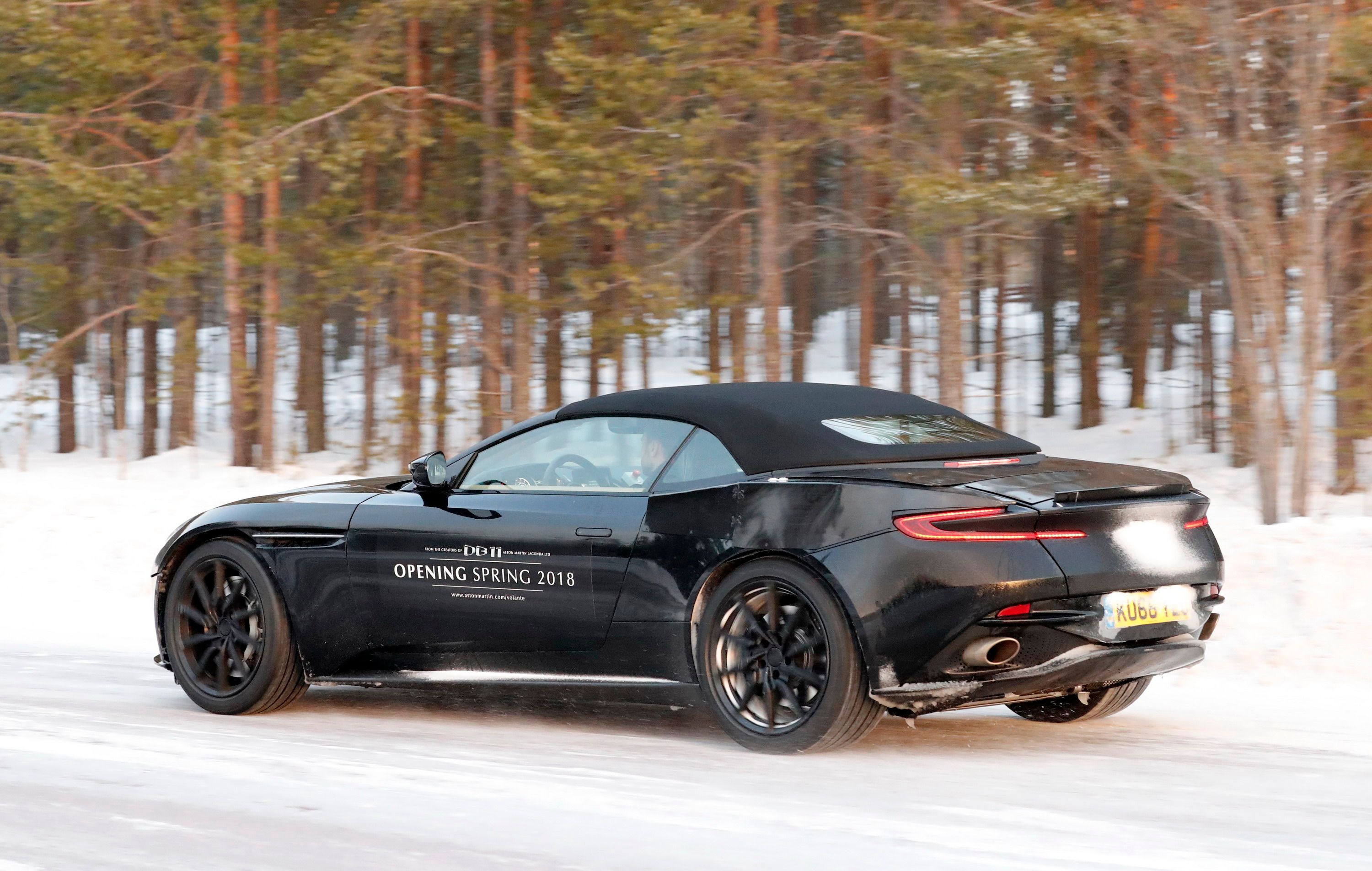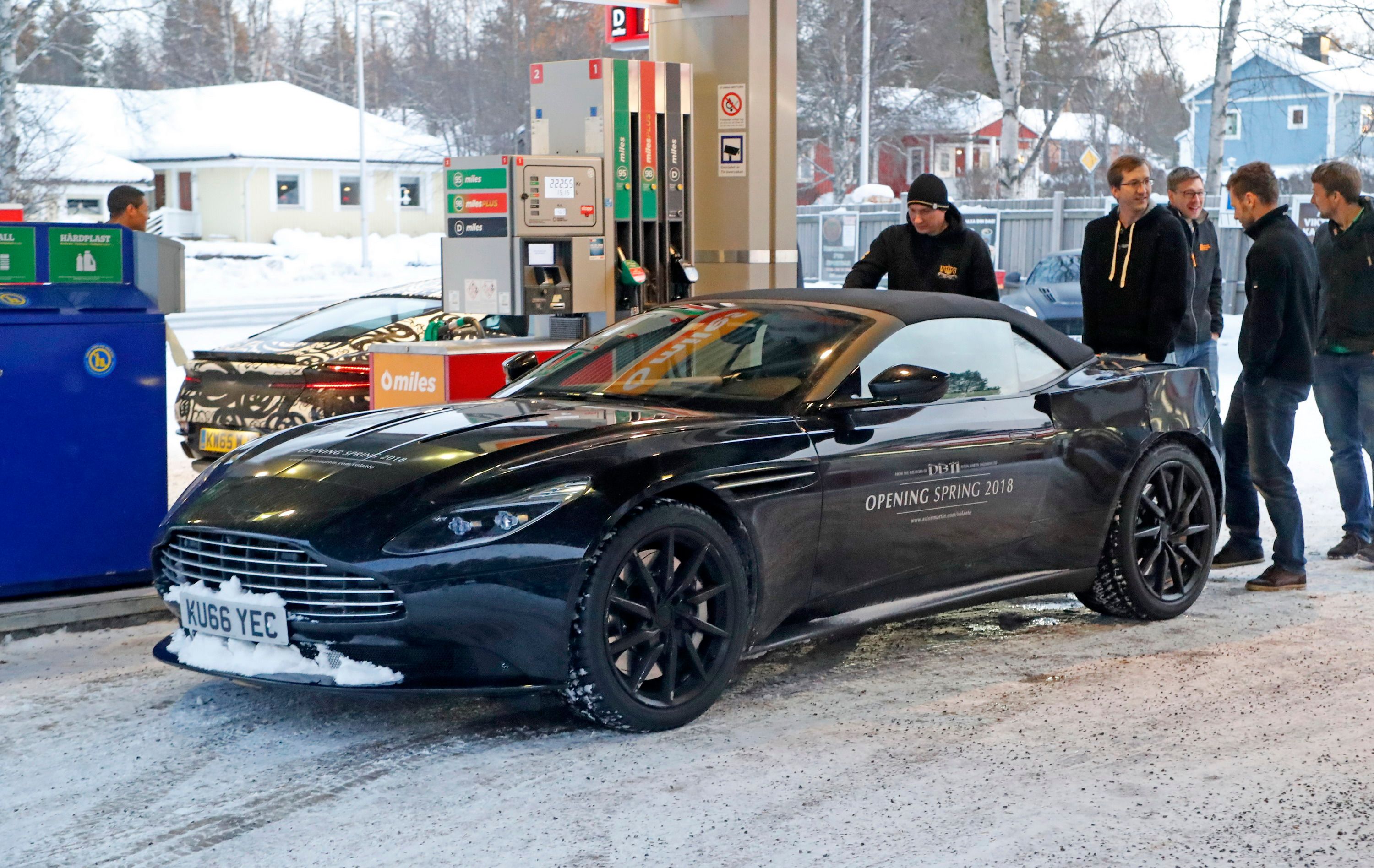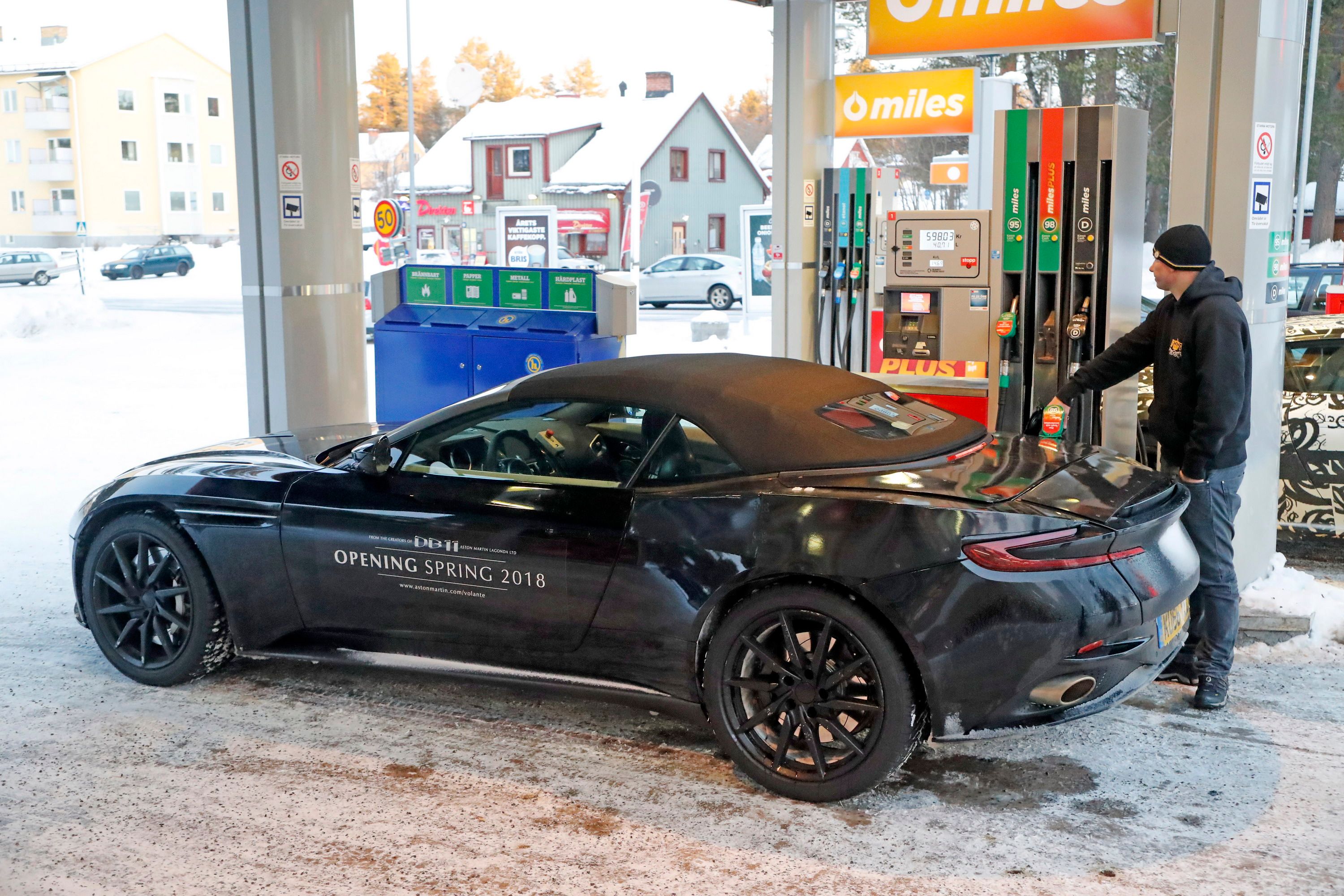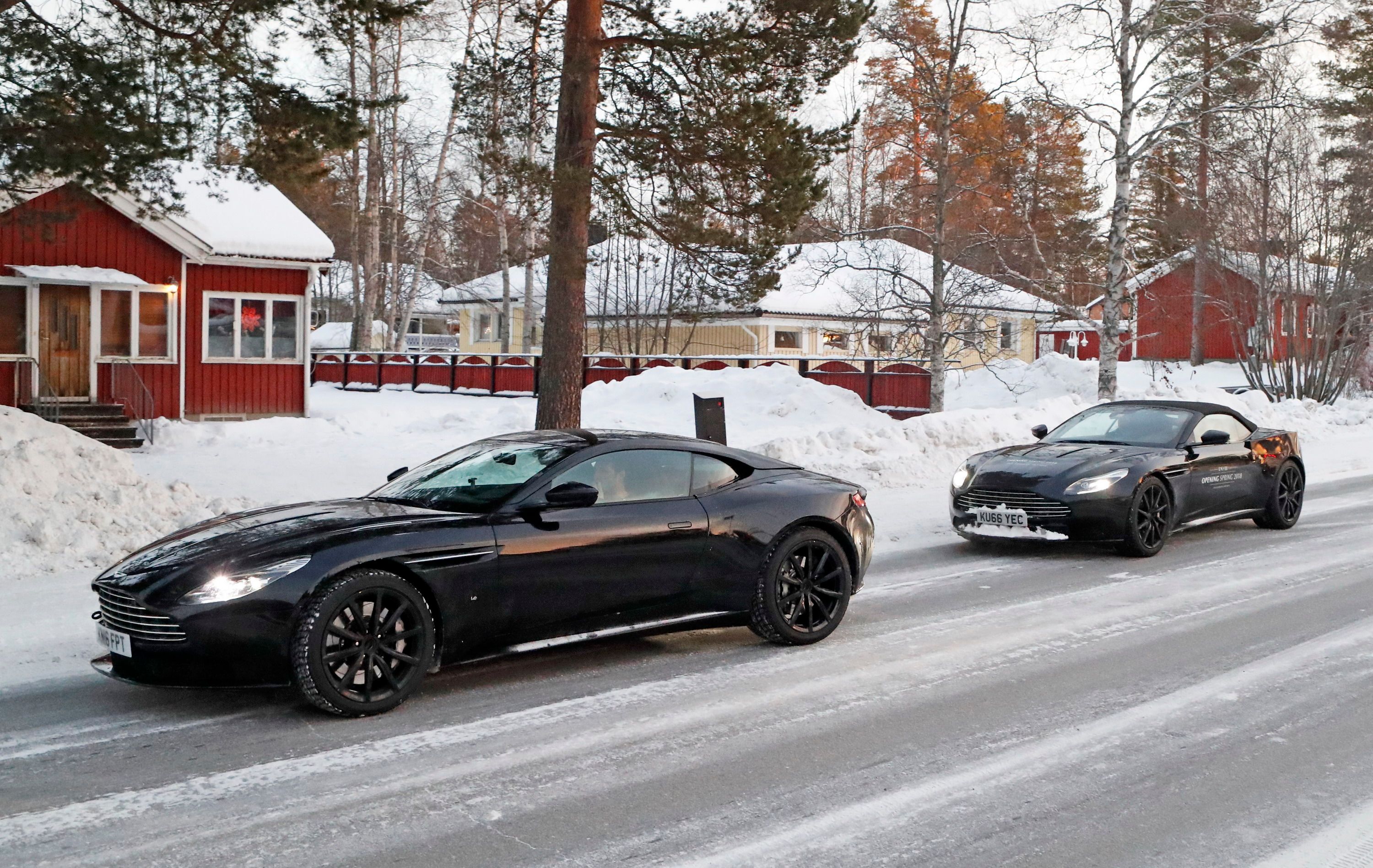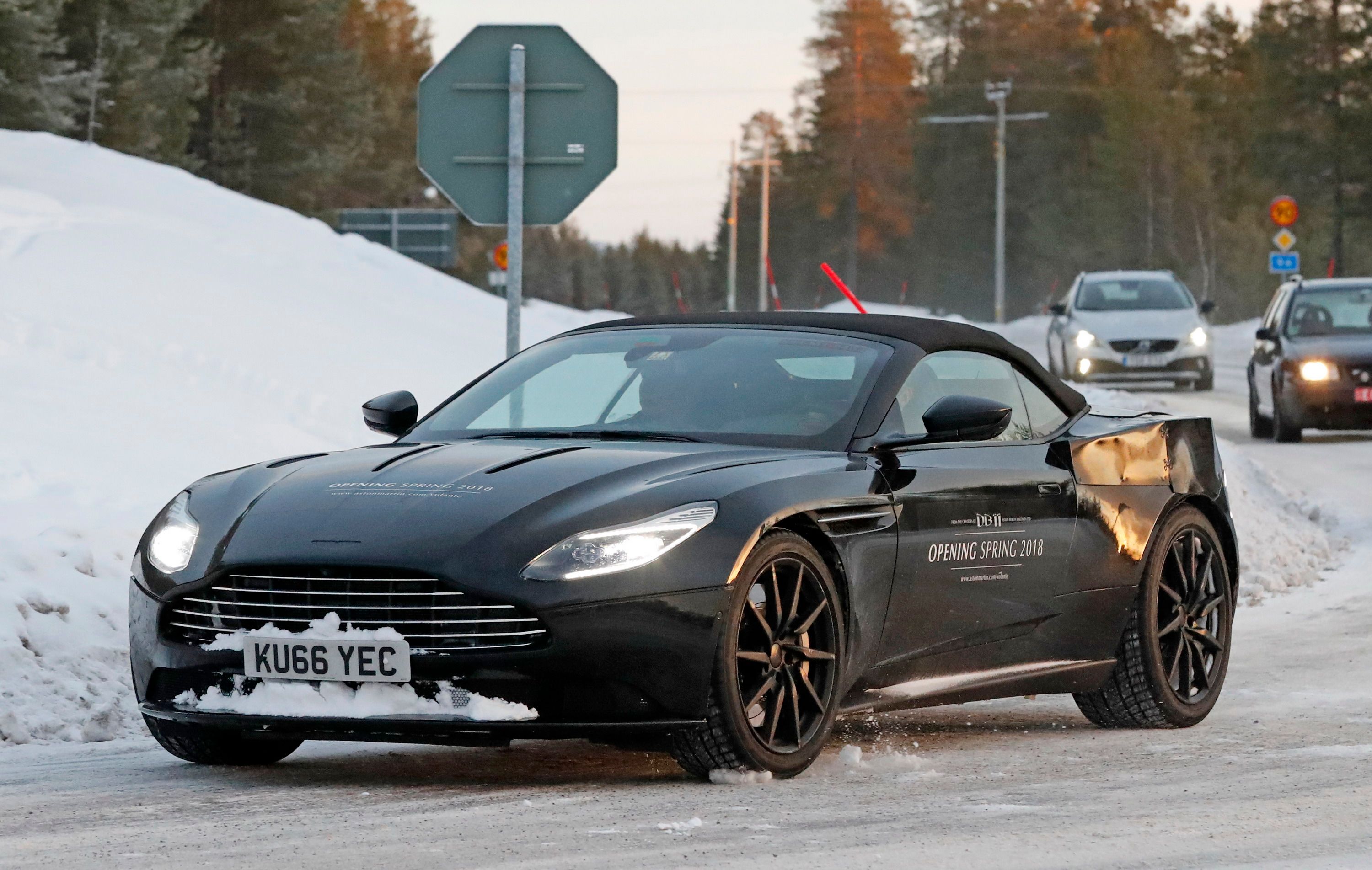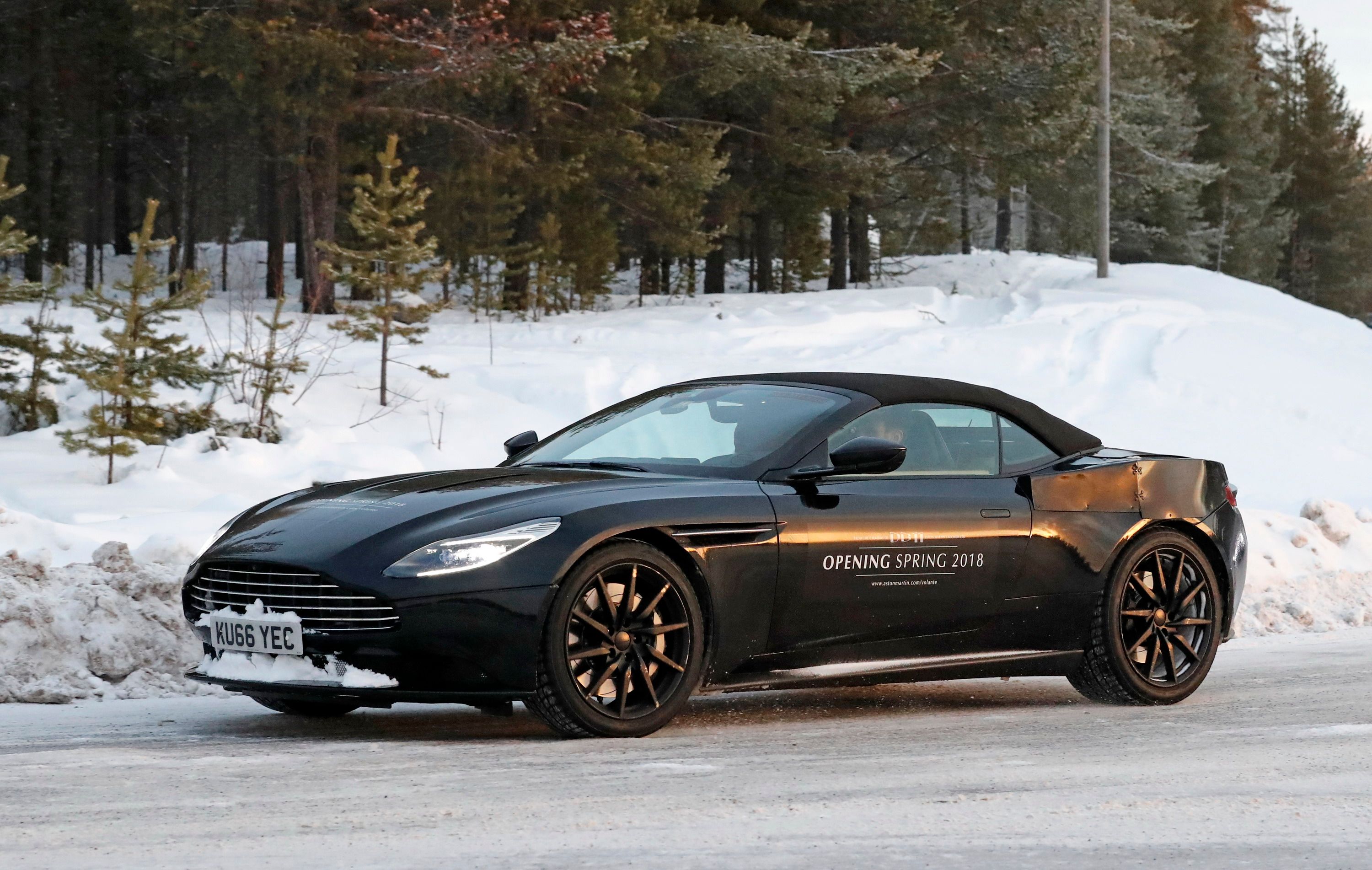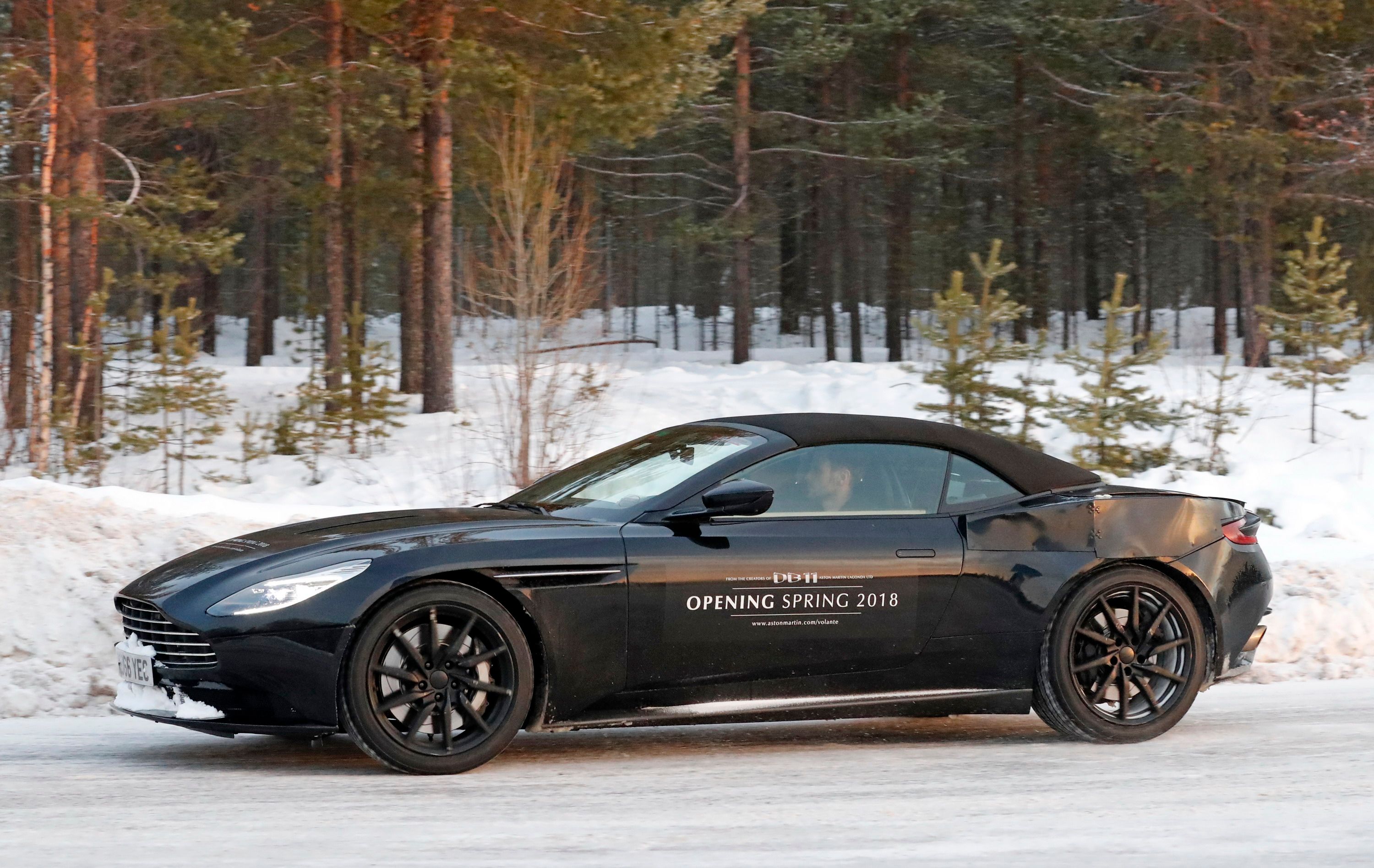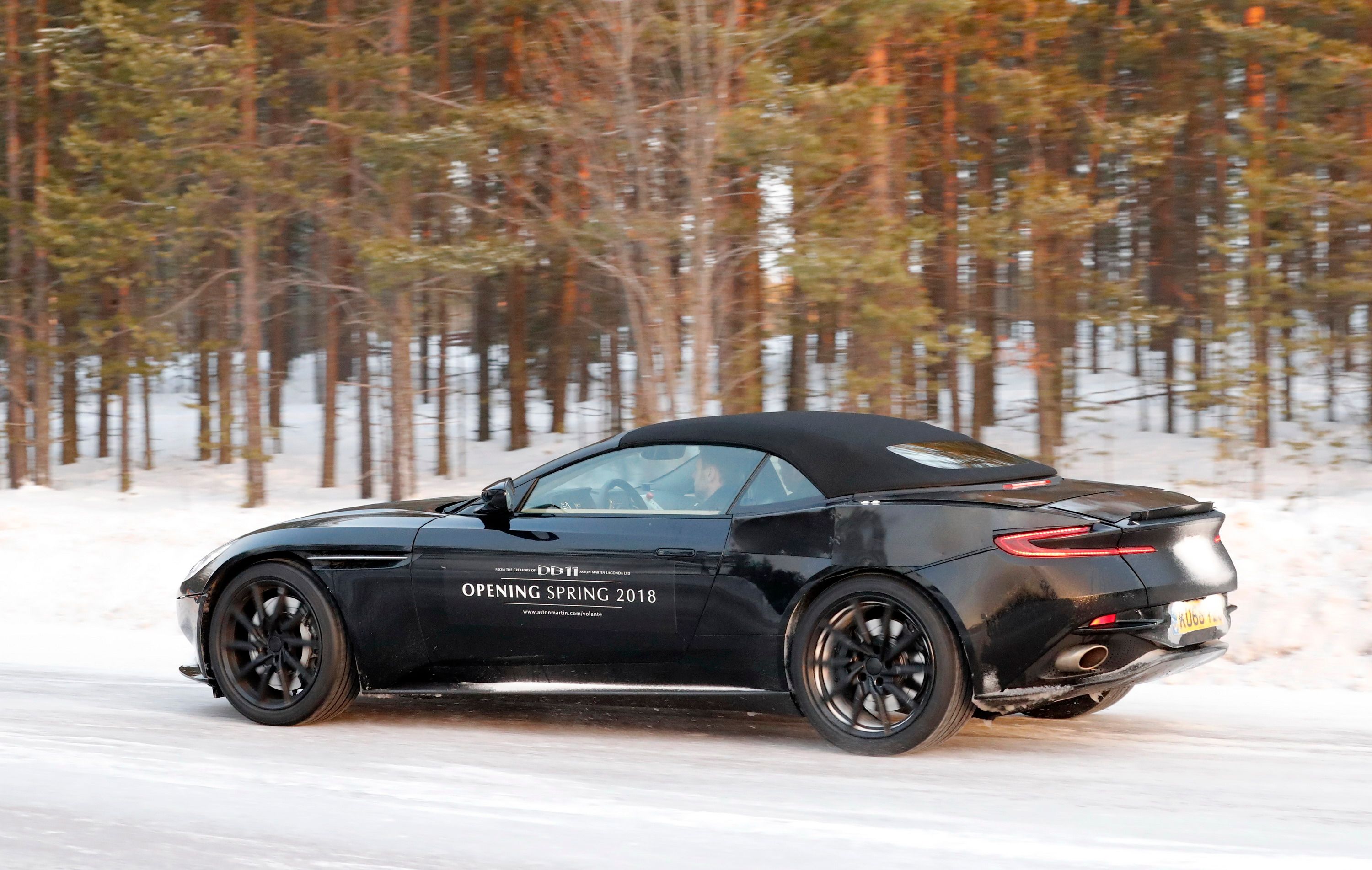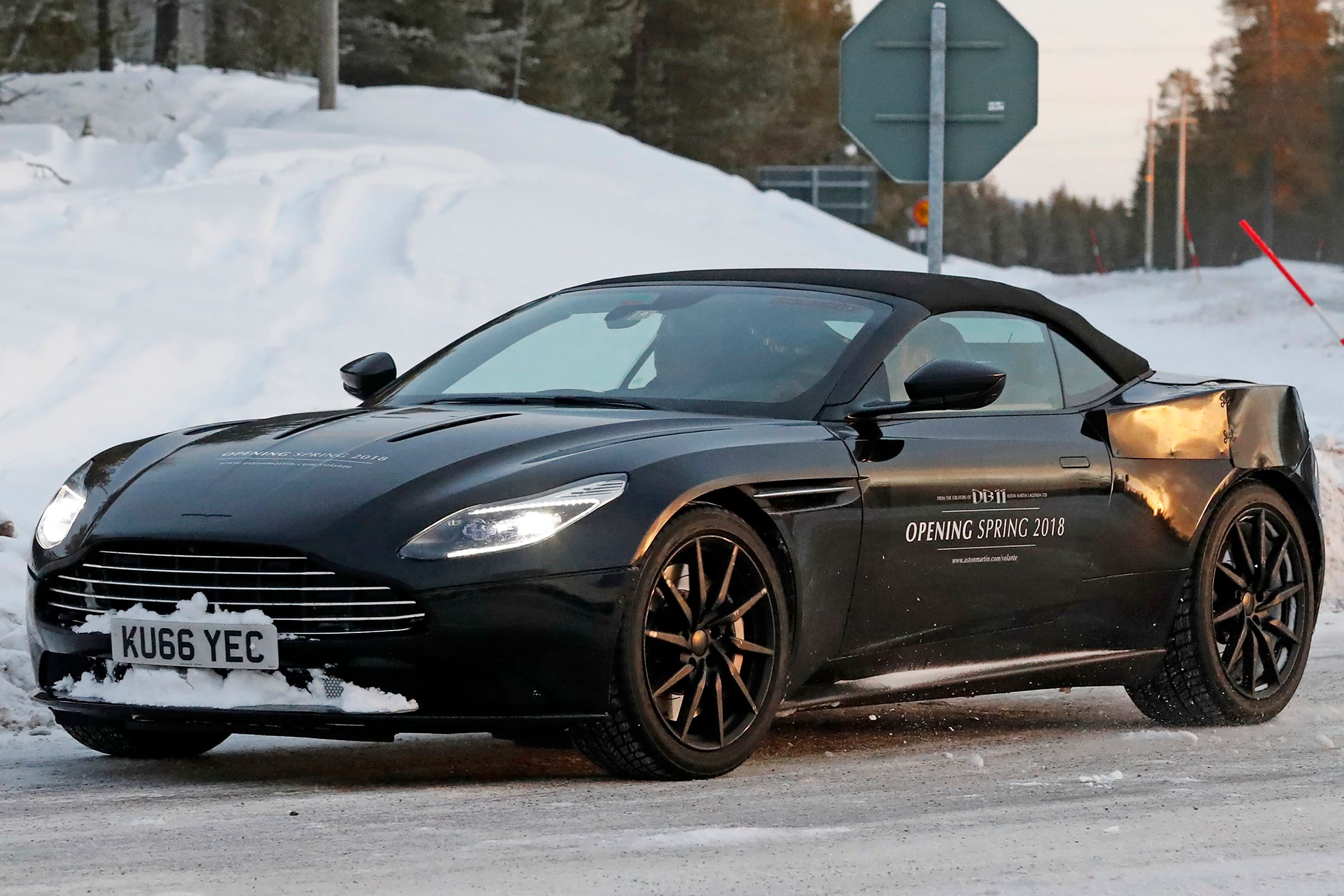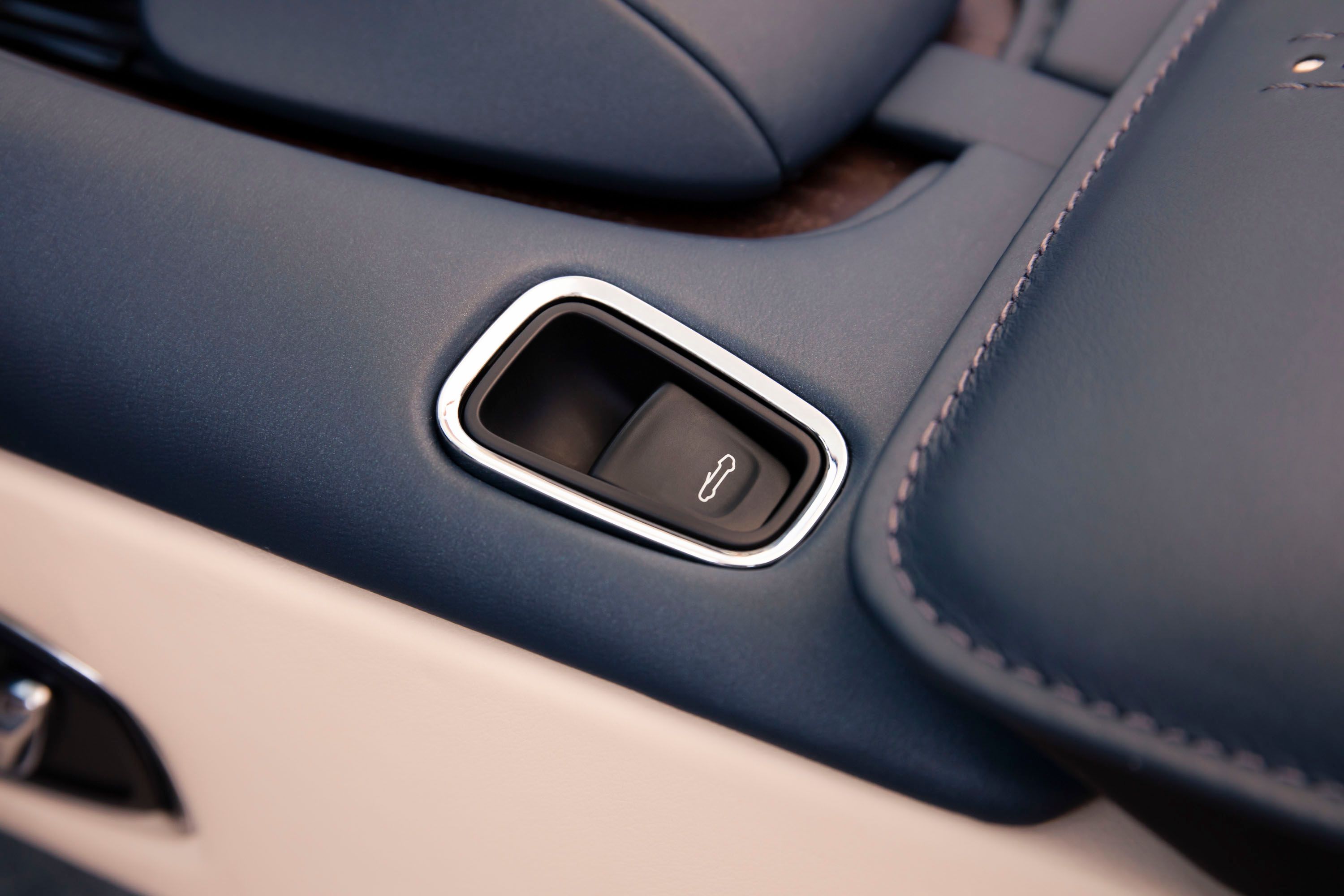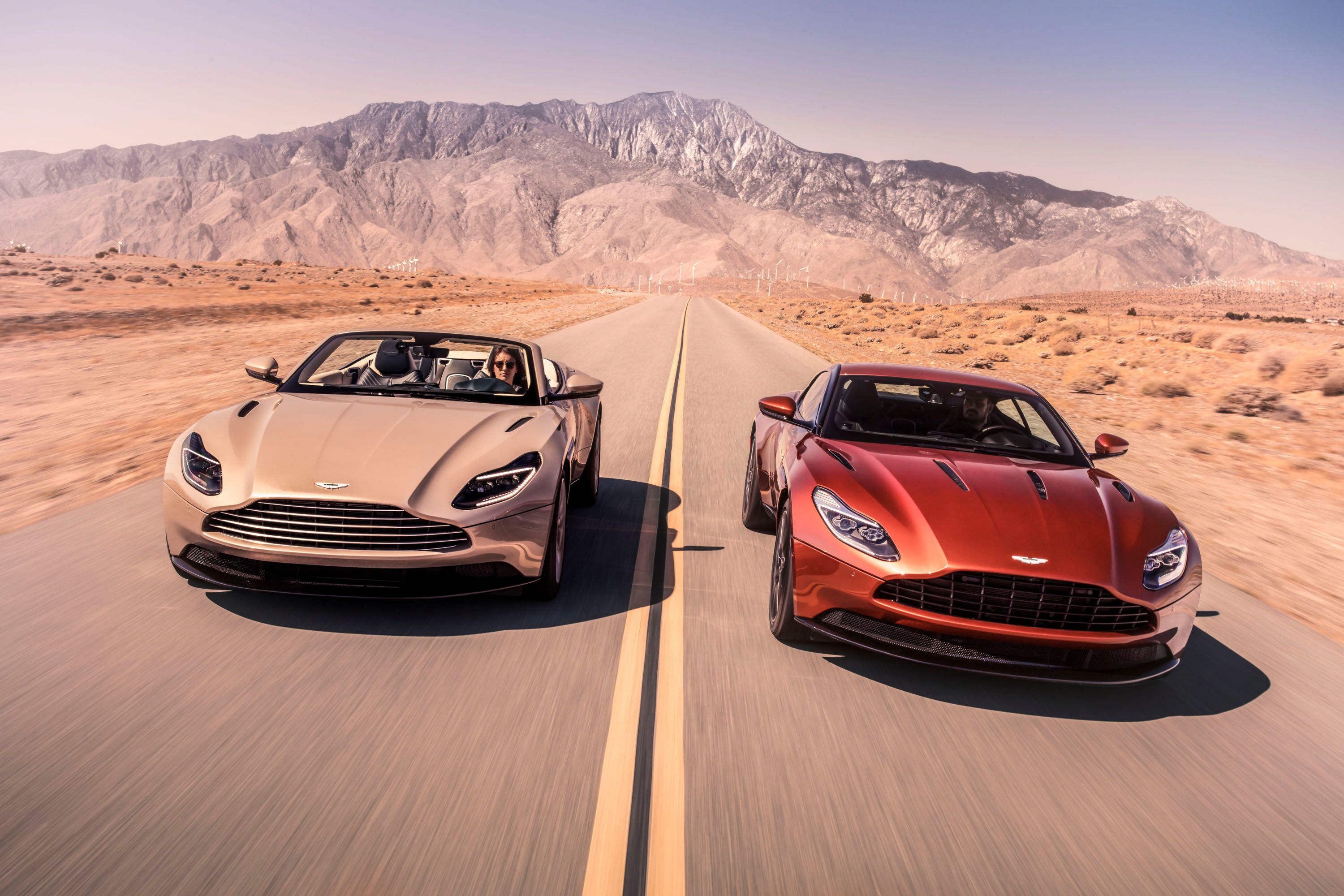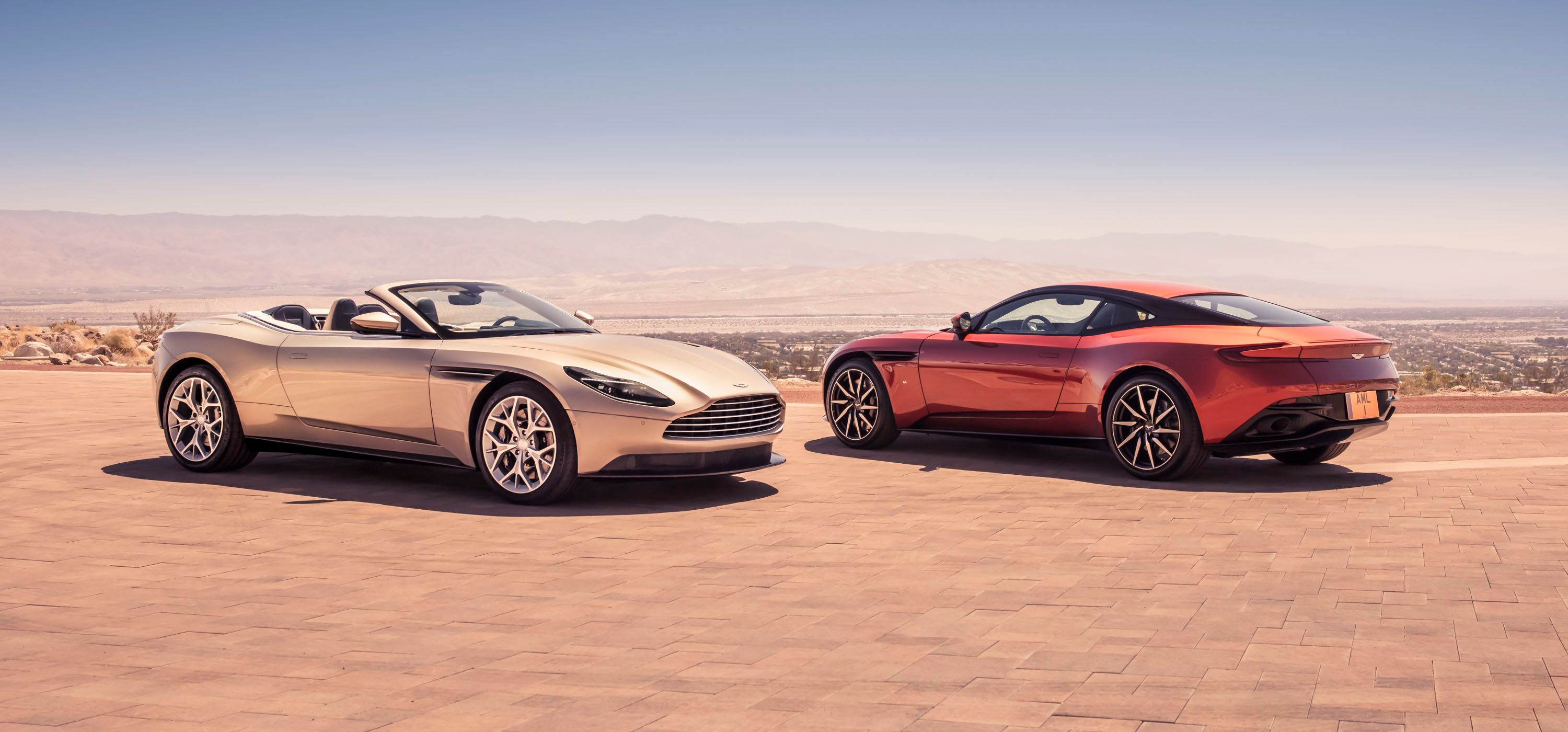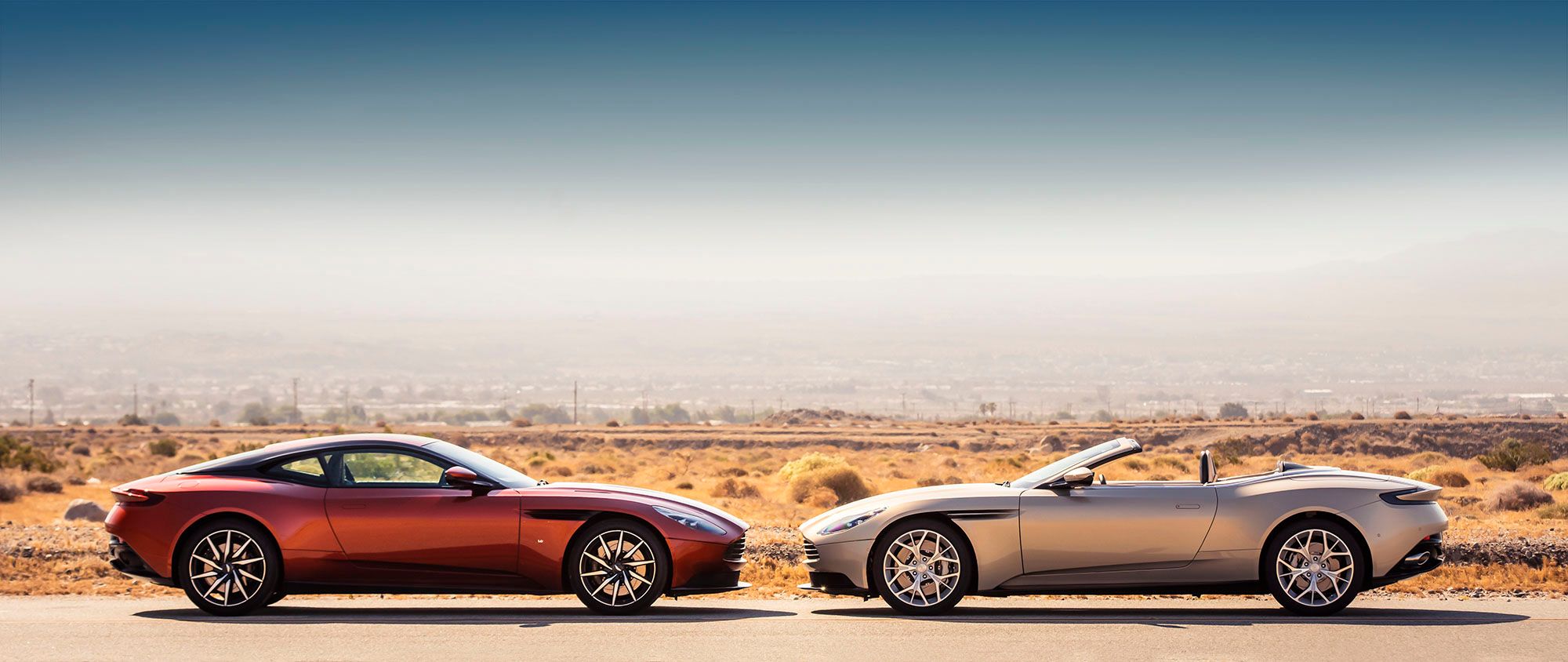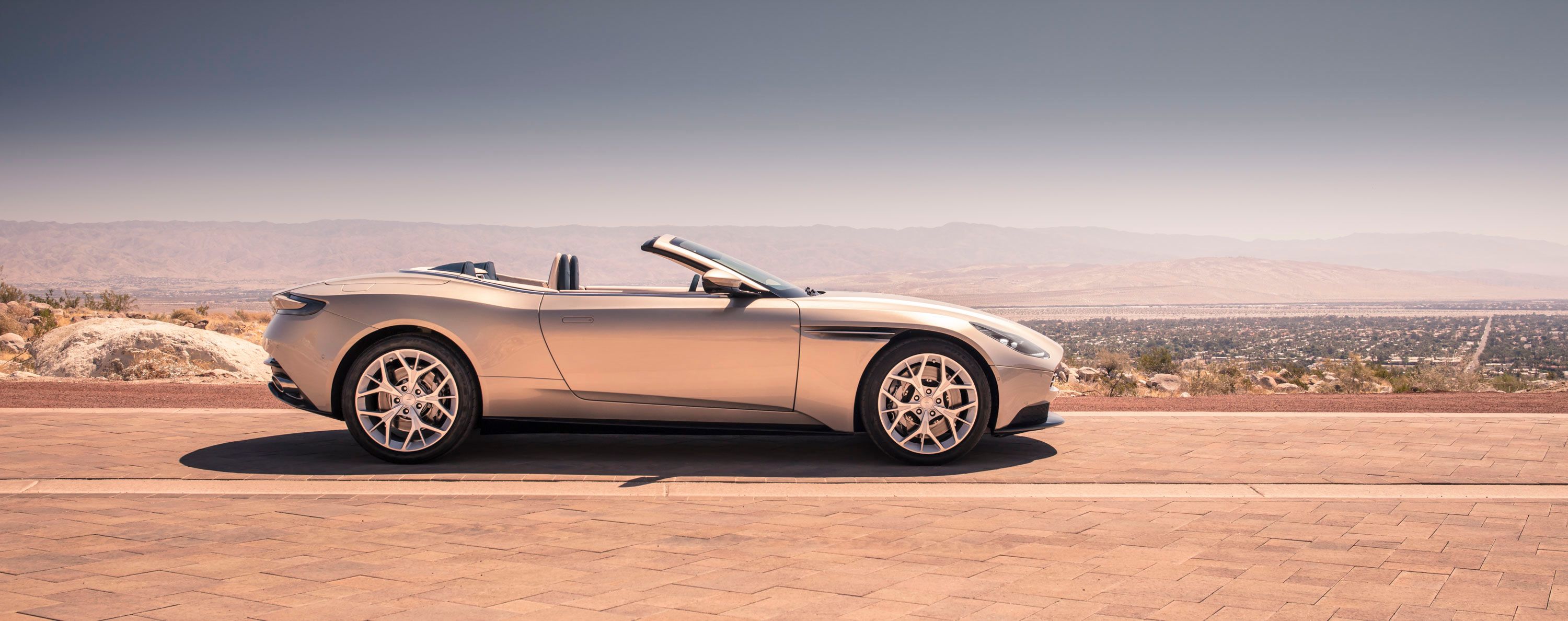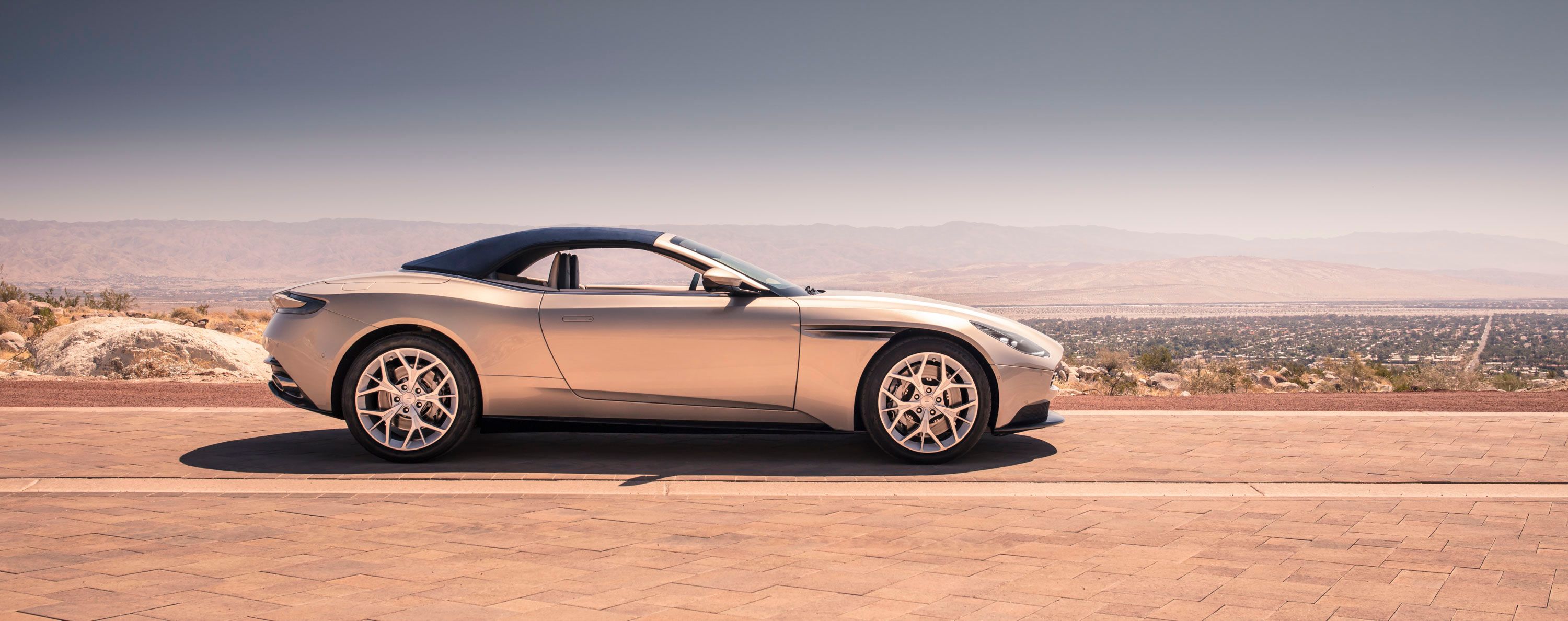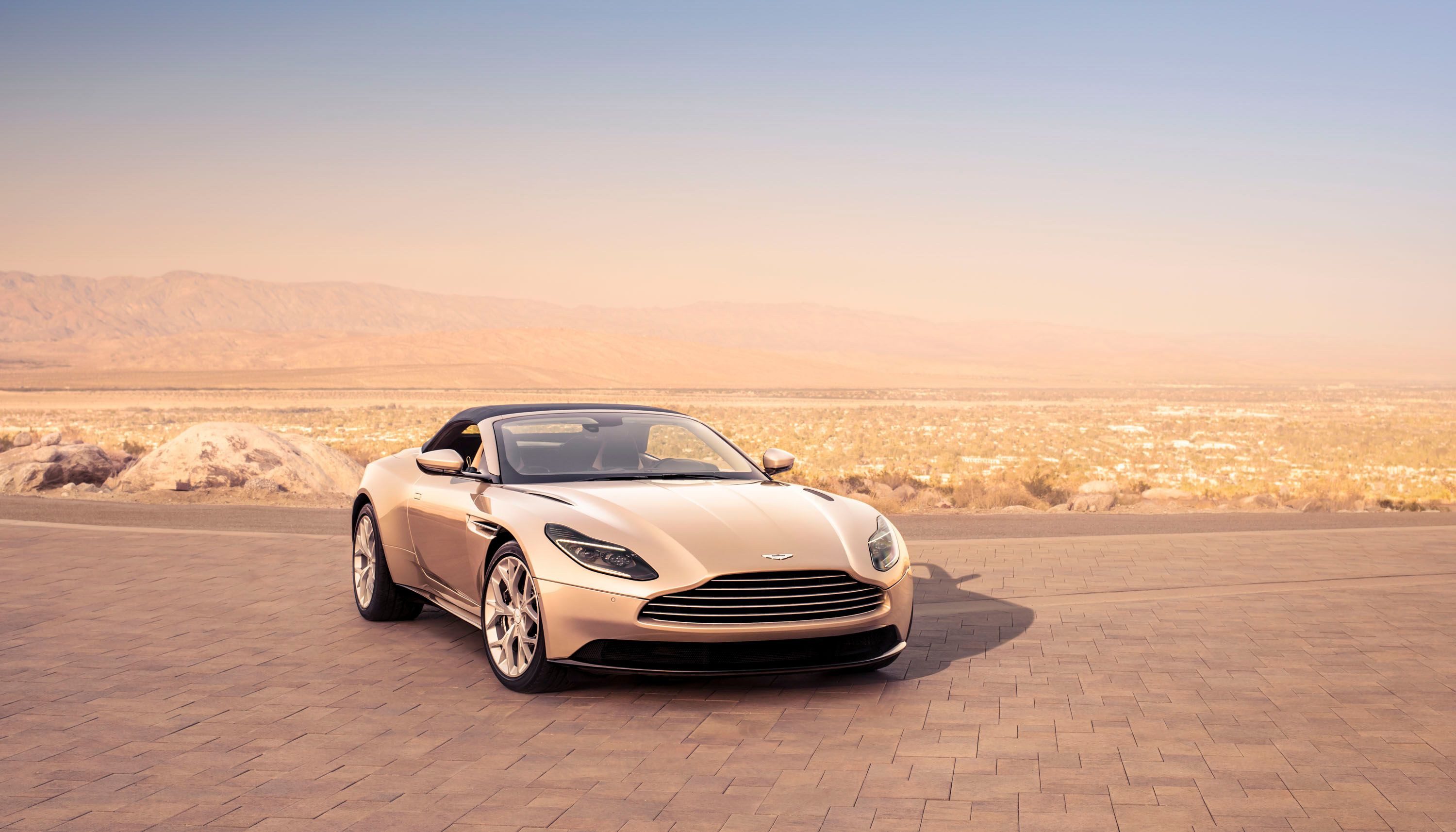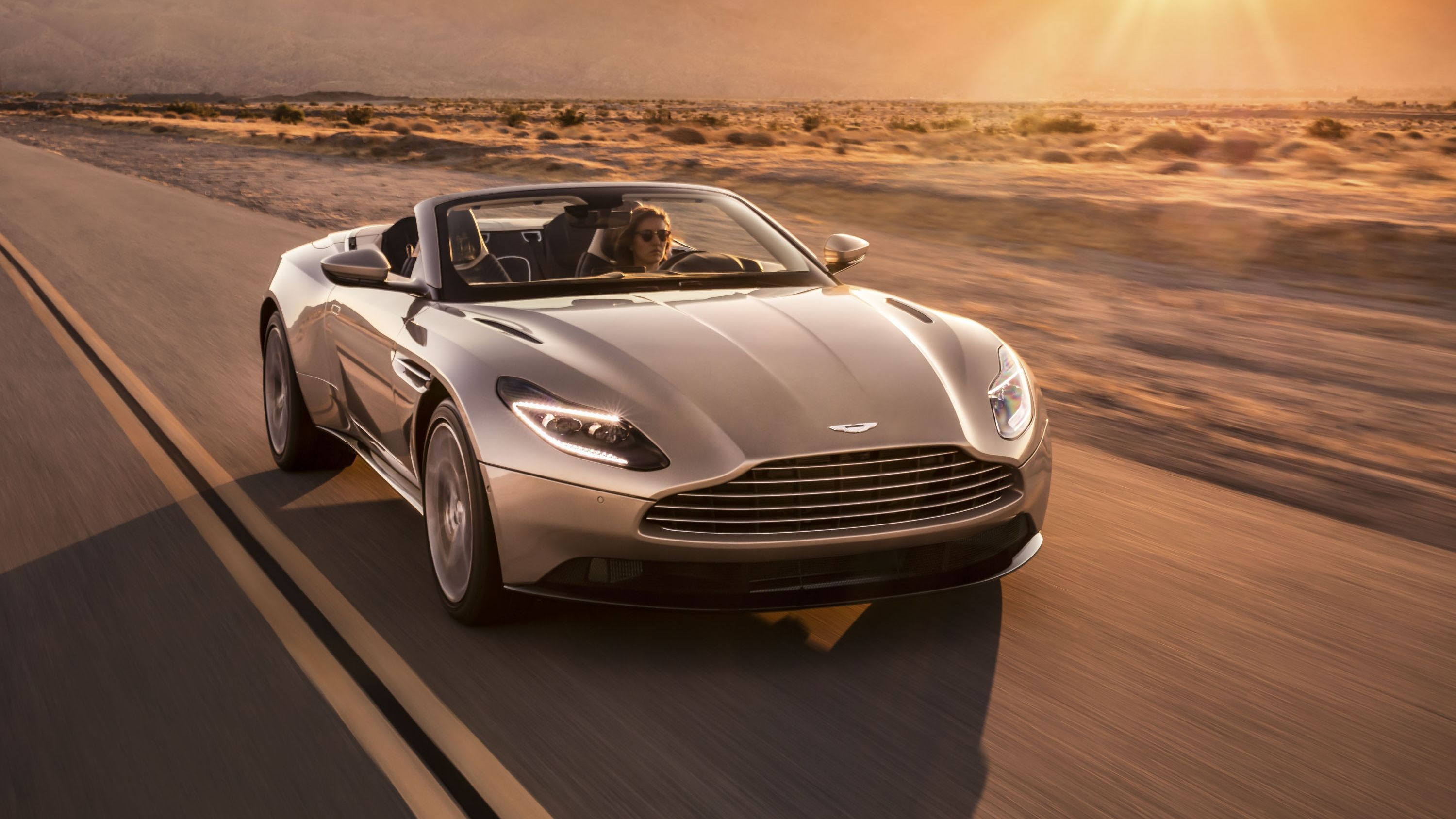The DB11 Volante was officially announced by Aston Martin in October of 2017. While being on its way to dealers is a pretty big deal, what seems more important to mention here is that the new DB11 Volante maintained the same sporty look even with that canvass top up or down – now that’s a pretty sweet deal. Initial models appear to only be offered with the AMG-sourced, 4.0-liter, V-8, which means you’re in for about 503 horsepower and 513 pound-feet of sheer man-pleasing goodness. For what it’s worth that engine is enough to deliver a four-second sprint to 62 mph in the coupe, and the Volante won’t be far behind.
With that in mind, the only real difference between the Volante and the coupe is quite obvious – that fabric top. But, you’ll be wanting to pop the champagne bottles when you see just how well Aston Martin managed to convert the coupe design into a drop top. This thing is absolutely gorgeous, and even has exactly what you would expect from an AM Volante. So, with that said, let’s dive on in and take a really good look at the new DB11 Volante. You might find yourself begging the wife to allow you to get one ;)
Continue reading to learn more about the 2018 Aston Martin DB11 Volante.
2018 Aston Martin DB11 Volante
- Make: Array
- Model: 2018 Aston Martin DB11 Volante
- Engine/Motor: V8
- Horsepower: 503
- Torque: 513
- [do not use] Vehicle Model: Array
Official video
Exterior
As you can see from the image above, Aston Martin did an amazing job converting the DB11 Coupe into the Volante – so well, in fact, that the car is nearly identical to the extent that it looks like the coupe has a slide-off roof. With that in mind, you get the same gorgeous front end with that wide-mouth, single-piece grill with five louvers, a huge splitter down below, and long, recessed headlights with that slender LED strip along the top and outer edge. The same hood also carries over with a long vent on either side near the fender and those defining, muscular lines that run from the windshield to the nose.
Walk over to the side like you’re going to embark this beast, and you’ll find that deeply cut vent in the fender to match that small air passthrough down in the corner of the side skit. The bottom of the side skirt also gets a small lip, which is just enough to tie the front and side profiles together. The body line just below the waistline rungs from the rear-most tip of the headlight back to the rear quarters, bending only beyond the doors to match the curvature of the muscular rear haunches. What you’ll find particularly interesting here is how most of the rear quarter matches that of the coupe, all the way up to where the waistline curves around to the rear and the top’s hood resides. It should also be mentioned that the Volante gets its own unique wheels that include a split-spoke layout that really adds to the overall character of the car.
Around back, we see more of the same. The Volante gets the same clear taillights with red LEDs and that huge gloss-black rear insert. Chrome exhaust tips add some serious contrast while the small red reflectors supplement the same. The one real different thing back here is the hood for the convertible top, which takes up a good portion of the rear deck. As you can see, the waistline curves up and around, with decreasing width before traversing across the rear deck. The only downside of the Volante as far as the exterior goes is that the rear deck kind of sticks out like a sore thumb with those massive gaps between boy panels. Of course, they match the rest of the car, really, but it would be nice to see a tighter fit and finish here.
On the other hand, it should be noted that when the top is up and in place, it isn’t quite as long as the roof on the coupe, giving the Volante a look of its own in closed mode. And, for what it’s worth, that top can be opened at up to 31 mph (less if there’s wind coming at you.) AM says it has tested the top in Death Valley and the Arctic and its reliability testing has shown 100,000 successful cycles, which should be enough to last for at least 10 years – now that’s enough to make me comfortable about it, how about you?
The Competition
The world of high-priced luxury convertibles isn’t really all that large, but the DB11 Volante will have some pretty stiff competition. With models like the Mercedes-AMG S65 Cabriolet, the Bentley Continental GT Convertible, and the Ferrari California T all occupying a big portion of this niche, there are some tough decisions to make if you’re really in the market for a $200,000+ convertible. All three of these models feature their own unique look, but all three feature a similar level of aggression in their design. The California T has that wide-mouth grille up front to go with small and sleek corner air vents. The hood has just the right amount of character without going overboard. Looking at the car from in front, the sides don’t look all that aggressive, but walk around to the side, and you’ll find an excessively sharp body line that runs from the contour of the front wheel arch back to the rear quarters, following the wavy contour of the body as you move farther back. The rear haunches are muscular while the rear fascia is aggressive. The rear deck is smooth and slopes downward gently in the rear while a fairly aggressive diffuser with three fins rounds out the exterior package. The California T isn’t a bad choice, but there are other options to consider.
Despite the fact that Mercedes is own by Daimler and Bentley being a part of the VW group of companies, it is a bit surprising that there are some similarities between these two competitors. Just look at the front fascia of each of these models. You can deny that the overall design of both front fascias are suspicious. Even the rear haunches on both of these models are vaguely similar. When it comes to the Bentley, you get the traditional tiered circular headlights and a rectangular grille up front. The hood features a defining line right in the middle and sits just below the level of the wheel arches. The windshield on this model is fairly short and features a massive pillar on each side. Moving back, there is a sharp body line that starts out ahead of the front wheel arch, whips around the top and shoots straight back, terminating just ahead of the door handle on each side. Another excessively sharp line comes into play above the rear wheel arches to had a hint of masculinity. Around back, the Bentley actually hs a somewhat ugly set up going on. The rear deck is long and smooth, with the lower edge in the rear acting as an overhang above the license plate. The exhaust outlets are recessed into the rear fascia, similar to what you see on a lot of Mercedes models.
Looking at the S65 Cabriolet, you’ll find that it’s styling in some areas are a little outdated. While the DB11 Volante and California T have these muscular rear haunches and an elevated waistline in the rear, the Merc is the exact opposite. It’s got an aggressive front fascia with the traditional AMG grille up front. The hood is fairly sporty, but the side profile is toned down compared to all of the other models we’ve discussed so far. The waistline itself stays the same all the way around as opposed to being slightly elevated in the rear. To me, this harkens back to old school Porsche convertibles from back in the day. That doesn’t mean it’s a bad car, and maybe you like that look, but if you want something that’s more minimalist on the outside, the S65 is probably your best bet. Around back, the S65 is has a bubbly appearance, with the fascia and rear quarters wrapping around with a gentle curve – a feature that’s comparable to what the DB11 Volante will have going on out back, but completely different from the California T and the Bentley GT.
|
Aston Martin DB11 Volante} |
||||
|
Wheelbase (Inches) |
105.1 |
108.0 |
115.94 |
110.43 |
|
Length (Inches) |
179.9 |
189.3 |
198.58 |
186.57 |
|
Width (Inches) |
75.2 |
76.7 |
75.31 |
76.37 |
|
Height (Inches) |
52.0 |
55.1 |
56.29 |
50.35 |
All told, the DB11 Volante and these three competitors are all fine automobiles, but as far as looks go, it really depends on your taste. If you want something that’s aggressive, I would suggest going for the DB11 or the California T. If you want something big, and somewhat toned down in comparison; you’ll want to choose between the Bentley and the Merc. But, it’s not all about looks, so let’s see what else these models bring to the table.
Interior
Inside, the Volante takes on the same exact DNA has its metal-topped sibling. Needless to say, it does have the unlimited headroom when you have to top down. According to Aston Martin, you can lower the top in just 14 seconds and raise it in as little as 16 seconds. Of course, you can’t do so at high speed, but according to AM, it can be done at speeds of up to 31 mph with no headwind. Since the new top is lighter than that of the DB9, you’ll actually find the storage space in the trunk has increased by as much as 20 percent in comparison. It’s still not as much as you’ll find in the coupe, but that’s a pretty big improvement. The top itself features plenty of acoustic and insulation, and with eight layers of material, it helps combat wind noise and unfriendly temperatures when you can’t enjoy having the top down. Top colors include red, black silver, and gray silver.
Speaking of the top, it should be pointed out that Aston Martin did what it could to ensure that you can enjoy topless (giggity) driving as often as possible, thanks to a heated steering wheel. The rear seats, while they are quite small, feature ISOFIX attachments, something not usually found in an AM convertible and a safe way to attach your child’s seat in the rear. Finally, the Volante stands out the most thanks to the addition of new wooden veneers to the back of the front seats. They can also be had in carbon fiber if you wish to go with the carbon look.
Outside of what I’ve already mentioned here, the DB11 Volante carries over with the same classic GT look found in the coupe. We’re talking about the single-gauge, semi-digital instrument cluster and the just-out-of-round steering wheel that has a flattish bottom and sharply curved corners that almost give it a square look. You’ll also find two little ledges inside the 2- and 10-O’clock positions to provide a bit of extra support for your thumbs when you grip the wheel correctly. Over in the center stack, you’ll find the eight-inch display screen and the simple button layout to control the infotainment and HVAC systems. Shifting duties are handled by paddle shifters behind the wheel, so there’s no need for a shifter in the center. As such, you get a touch controller and a button for the electric parking brake.
The dash features a genuinely smooth design with just a few defining lines in the center and the middle while the seats and central armrests feature a center stitching in a contrasting color. The inserts of the seats contrast the outsides to match the contrast of the dash and the door panels and feature a unique and curved stitching pattern – nice! All told, it’s a pretty nice interior, and even better with the top down, so how does it compete with the competition?
Competing Designs
All three competitors offer amazing interiors, so if the choice of which to buy comes down to the interior, you’re going to need some time to sit in each and really soak in what each has to offer. While the DB11 will feature a floating infotainment screen that rests atop the center stack, all three of these competing models have the display integrated into the center stack. The Mercedes-AMG S65 (top left) features a digital instrument cluster that integrates almost seamlessly with the wide display sitting in the center stack. It is a very modern look, but that’s not all that makes the S65 desirable. The dash is actually rather tame compared to the Bentley, Ferrari, and Aston Martin, and swoops downward just a bit on each end where it has a very tight fit against the door trim panels. The upper portion of the dash and the door trim are one color, while the rest of the trim is done up in a contrasting color. The round HVAC vents are similar to that of the Bentley and Ferrari, but that’s what helps to set the DB11 apart as it has rectangular vents. Like the DB11, the seats of the S65 feature a unique stitching layout that is both sporty and stylish.
When you look at the Bentley (top right,) you’ll find a cockpit-like feel with a very sharp layout that keeps most of the controls and goodies in the center of the vehicle. The Bentley has an analog instrument cluster, and the infotainment display is recessed into the center stack. The dash itself is one of the most aggressive out there, with the driver and passenger side of it separated by that stylish and sporty dash bad. Because of this design, the whole center stack is recessed into the dash a bit giving a unique look. The shifter handle sits far forward, but there isn’t any space that’s unused as there are buttons and controls located everywhere on the center console. A split armrest covers up a large storage compartment. Beautiful wood inserts adorn the face of the dash, while the rest of the interior gets a two-tone look. The seats have a retro look with straight fluting. The lower side bolsters and headrests are done up in a dark contrasting color while the center inserts and upper side pollsters are done up in a lighter color. Various leather options are available at the time of purchase, and you can opt for some Alcantara as well. On the technology front, the Bentley benefits from LED lighting, wireless phone charging, and an available Wi-Fi hotspot, among other things.
Then we’ve got the California T (bottom) that also has a very interesting interior. Like the DB11 and other competitors, the California T gets a two-tone interior. It, like the Bentley and Merc, has circular HVAC vents, but on they are mounted atop the dash and protrude in an extreme fashion like Chameleon eyes. Oddly, the steering wheel looks almost like it was ripped out of an F1 car, with lots of thumb buttons and a flat bottom. Unlike the other models we’ve discussed, the center stack on the California actually extends outward a bit making access to it easier on the driver. The center console disappears into the dash below the HVAC controls. Unlike the other models we’ve discussed, there isn’t a traditional shifter. Instead, the California T make use of buttons to select park, drive, and reverse. This makes for a thinner center console that has a very clean look. Somehow, Ferrari managed to keep things minimal while providing an aggressive and pleasing package. Not bad at all.
|
Ferrari California T |
Bentley Continental GT Convertible |
Mercedes-AMG S 65 Cabriolet |
Aston Martin DB11 Volante |
|
|
Seats |
4 |
4 |
4 |
4 |
|
Passenger Volume (cu ft) |
75.0 |
86.0 |
TBA |
TBA |
|
Cargo Volume (cu ft) |
12.0 |
9.1 |
TBA |
TBA |
|
Cargo Volume (Seats Folded) |
TBA |
TBA |
TBA |
TBA |
Drivetrain
Under the hood, the Volante comes with a 4.0-liter, twin-turbo, V-8 that is sourced from none other than Mercedes-AMG. And, if you know your cars, you’d know that the AMG GT also makes use of the very same engine. And, while that may be the same, the collaboration between Aston Martin and Mercedes-AMG was a good one, as the brand allowed Aston to design their own specific parts, including engine mounts, a slim-line wet sump oil system, throttle mapping, and even their own ECU software. All told, you’ll find yourself with 503 horsepower and 513 pound-feet of torque on tap. That horsepower number be recognizable as that’s exactly how much the pre-facelift Mercedes-AMG GT S delivered, but its torque comes much closer to that of the Mercedes-AMG GT R.
To help keep things steady, Aston Martin went so far as to optimize the car’s center of gravity and included special suspension bushings, geometry, anti-roll bars, springs, dampers, and ESP software to help improve the car’s overall agility even with the top in the stowed position. And, you’ll be sure to know it’s a sports car. It might be a little heavier than it’s coupe sibling, but it shouldn’t take you too long to get up to 62 mph – the coupe does it in four-seconds flat, and the Volante should be able to do it in around 4.1 or 4.2 seconds at worst – not bad for a convertible of this caliber.
But, what about the V-12?
Yeah; what about the V-12? Well, if you think back a bit, you’ll remember that the DB11 coupe was originally rolled into dealers with just one engine as well. It was until about a year later that the DB11 found itself toting around the option for a V-8 and a V-12. As such, the Volante should experience the same fate, with the V-12 coming into the mix buy mid-to-late 2018. If I were you, I’d wait for the V-12, as its newly developed in the past year and delivers a cold-hearted 600 horsepower and 516 pound-feet of torque. For the coupe, that was an increase of 97 ponies and 59 pound-feet over the DB9 – a very nice improvement. The Coupe could hit the 62-mph sprint in as little as 3.9 seconds and tops out around 200 mph. So, with that in mind, the Volante should be able to hit around 196 (it is a little less aerodynamic) while the 62-mph sprint should come in around four-seconds flat.
The Competition
So, how does the competition stack up? It’s a good thing you asked, because in this niche that could be what makes or breaks your decision to go with one model or the other. With that said, we’ll start out with the least-powerful option first: The California T.
Powered by a direct-injected, 3.9-liter V-8, it doesn’t exactly have the largeness of all the other models we’re discussing. But, that doesn’t mean it’s a slouch by any means. See, Ferrari took this tiny V-8 and massaged it to deliver a decent 560 horsepower and 557 pound-feet of torque. That’s less than the Volante, Continental, and S65, but don’t judge the car until you’ve taken a ride in it. That power, lets the California T hit 62 mph in a butthole-puckering 3.6 seconds. And, there is literally no turbo lag, thanks to Ferrari’s amazing ingenuity. Top speed, like the DB11 Volante, comes in at 196 mph. Despite its amazing ability to get up to speed insanely fast, the California T is rated at 10.5-liters per 100km, which converts to about 22.4 mpg here in the U.S. An F1, dual-clutch, seven-speed automatic handles shifting duties, while a smooth and comfortable ride is made possible by double wishbone suspension in the front and a multilink system in the rear. But, if you really want to impress, you’ll want to click the option box for the Handling Speciale package. It brings a tighter recalibration to the engine and transmission as well as an all-new exhaust system. If you plan on hitting the track, this package is a must-have.
Next on the list is the Continental. Unlike the other models we’ve discussed, this baby comes with Bentleys famed 6.0-liter, twin-turbo, W-12 that delivers a decent 582 horsepower and 531 pound-feet of torque. Despite weighing an insane 5,501 pounds – that’s a much as a large SUV from the early 2000s – it can hit 60 mph in as quick as 4.7 seconds to go with a top speed of 191 mph. In the U.S. it is rated at 20 mph on the highway, 12 mpg in the city, and 15 mpg combined. It rolls on 21-inch wheels straight from the factory, and the suspension system is made up of air springs with continuous damping control – a feature that gives the Continental one of the best rides you can get in this Niche. On the options side of things, your best bet is to go with the carbon ceramic brakes if you’re going to do any spirited driving. It comes standard with Iron brakes, but these carbon ceramic units will help bring things to a stop quickly and efficiently while producing minimal dust.
Finally, we’ve got the Mercedes-AMG S65. This monster tips the scales at 4,981 pounds, but with 621 horsepower and 739 pound-feet of gut-wrenching torque on tap, this Cabriolet isn’t a model you want to turn your back on. That kind of power gets it up to 60 mph in four seconds. Its official top speed has yet to be published by Merc, but all Mercedes models are generally limited to 155 mph, so don’t expect to go much faster without having the electronic limiter increased to 186 mph with the AMG Driver Package (a must-have in my opinion.) The engine itself is a hand-built 6.0-liter V12 that is built in-house by Mercedes-AMG. Power is sent to all four wheels via a 7G-Tronic AMG Speedshift Plus automatic. Fuel economy is rated at 14 mpg in the city and 21 mpg on the highway, which puts it right on par with the California T. All told, the Mercedes is the most powerful of the bunch, but if you really want the fastest, you’ll have to buy Italian on this one.
|
Ferrari California T |
Bentley Continental GT Convertible |
Mercedes-AMG S 65 Cabriolet |
Aston Martin DB11 Volante |
||||
|
Ferrari California T |
Bentley Continental GT Convertible |
Mercedes-AMG S 65 Cabriolet |
Aston Martin DB11 Volante |
3.9-liter V-8 |
6.0-liter, twin-turbo, W-12 |
6.0-liter V-12 |
5.2-litre twin-turbo V-12 |
|
Engine |
552 HP @ 7,500 RPM |
582 HP @ 6,000 RPM |
630 HP @ 4,800-5,400 RPM |
600 HP @ 6,500 RPM |
|||
|
Horsepower |
557 Lb-FT @ 4,750 RPM |
531 LB-FT @ 1,800 RPM |
737 LB-FT @ 2,300-4,300 RPM |
516 LB-FT @ 1,500-5,000 RPM |
|||
|
Torque |
196 mph |
196 mph |
196 mph (est.) |
155 mph |
|||
|
Top speed |
3.6 s |
4.7 s |
4.1 s (est.) |
4.1 s |
|||
|
0-100 km/h (0-62 mph) |
3,582 Lbs |
5,501 Lbs |
4,971 Lbs |
TBA |
|||
|
Dry weight |
3,813 Lbs |
6,393 Lbs |
5,789 Lbs |
TBA |
|||
|
Kerb weight |
47% front - 53% rear |
57 % front - 42% rear |
TBA |
TBA |
Prices
Aston Martin was quick to release pricing this time around, and the Volante comes in at a pricy, $216,495 here in the U.S. Over in the U.K., you can park one in your driveway for £159,900, and you can have one in Germany for €199,000. Needless to say, it doesn’t come cheap, but beautiful things seldom do, right?
Competing Prices
With Volante hit the wallet for $216,495, you might want to consider grabbing yourself a Bentley Continental GT Speed goes $218,400; the 2016 California T retails for $202,723, and the Mercedes-AMG S65 Cabriolet commands at least $247,900. So, unless you’re a major fan of Mercedes, that S65 is a pretty hard one to go for, considering you can get a faster and equally stylish California T for more than $40,000 less. Then again, you could go with the biggest status symbol out there and get yourself a Bentley for about $220k. Either way, you can’t go wrong with the Ferrari or the Bentley, but I think the DB11 Volante will probably win your heart.
Other Options
Porsche 911 Turbo S Cabriolet
2}Sometimes you save the best for last, and I may very well have done that here. See, the Porsche 911 Turbo S looks wildly different than the rest of the models here, including the upcoming DB11 Volante. Over the years the 911 has changed a lot, but it’s still stuck to its classic German roots as far as design goes. And, if speed is something that speaks to you, then you better pay attention. The 911 Turbo S isn’t the most powerful model here, with just 580 horsepower and 553 pound-feet of torque. But, it’s aerodynamic and light, which means it can beat out even the California T. To put things simply, when equipped with the Sport Chrono package, the 911 Turbo S Cabriolet can hit 60 mph in 2.9 seconds – yes, you read that correctly – and tops out at 205 mph. That’s absolutely amazing for a cabriolet, and it gets decent fuel economy as well, being able to achieve 19 mph in the city, 24 mph on the highway, and 21 mpg combined. As of the time of this writing, the Turbo S Cabriolet for the 2017 model year goes for $200,400 in entry-level form. That price can increase drastically, though, depending on what options you choose, so don’t expect to roll out of the dealership for less than $230k unless you really have self-restraint.
Find out more about the Porsche 911 Turbo S Cabriolet.
Conclusion
As is the usual case with coupes going topless, there isn’t a whole lot that changes between the standard DB11 Coupe and the new Volante, but I have to admit that Aston Martin did a magnificent job in maintaining the sportiness of the coupe. I mean, there’s no real sacrifice here. The rear seating looks the same (with some new trim inserts on the seatback), and the car is identical all of the way up to the waistline and a little more in the rear. I’m a little disappointed that there isn’t a better fit and finish in the rear where the top stows away, but the seam gaps here match those around the car, so I guess it really isn’t that bad. The only negative thing I have to say is that it isn’t being initially released with the option for the V-12. Just like the coupe, you have to wait. I know good things come to those who wait, but if you have $200k sitting around and you really wanted a Volante, how hard would it be to wait for the V-12 to finally get released? Anyway, let us know what you think about the new DB11 Volante in the comments section below.
References
Aston Martin DB11
Read our full review on the 2017 Aston Martin DB11 Coupe.
Read our full speculative review on the 2018 Aston Martin DB11 S.
Rendering
Spy Shots
May 16, 2017
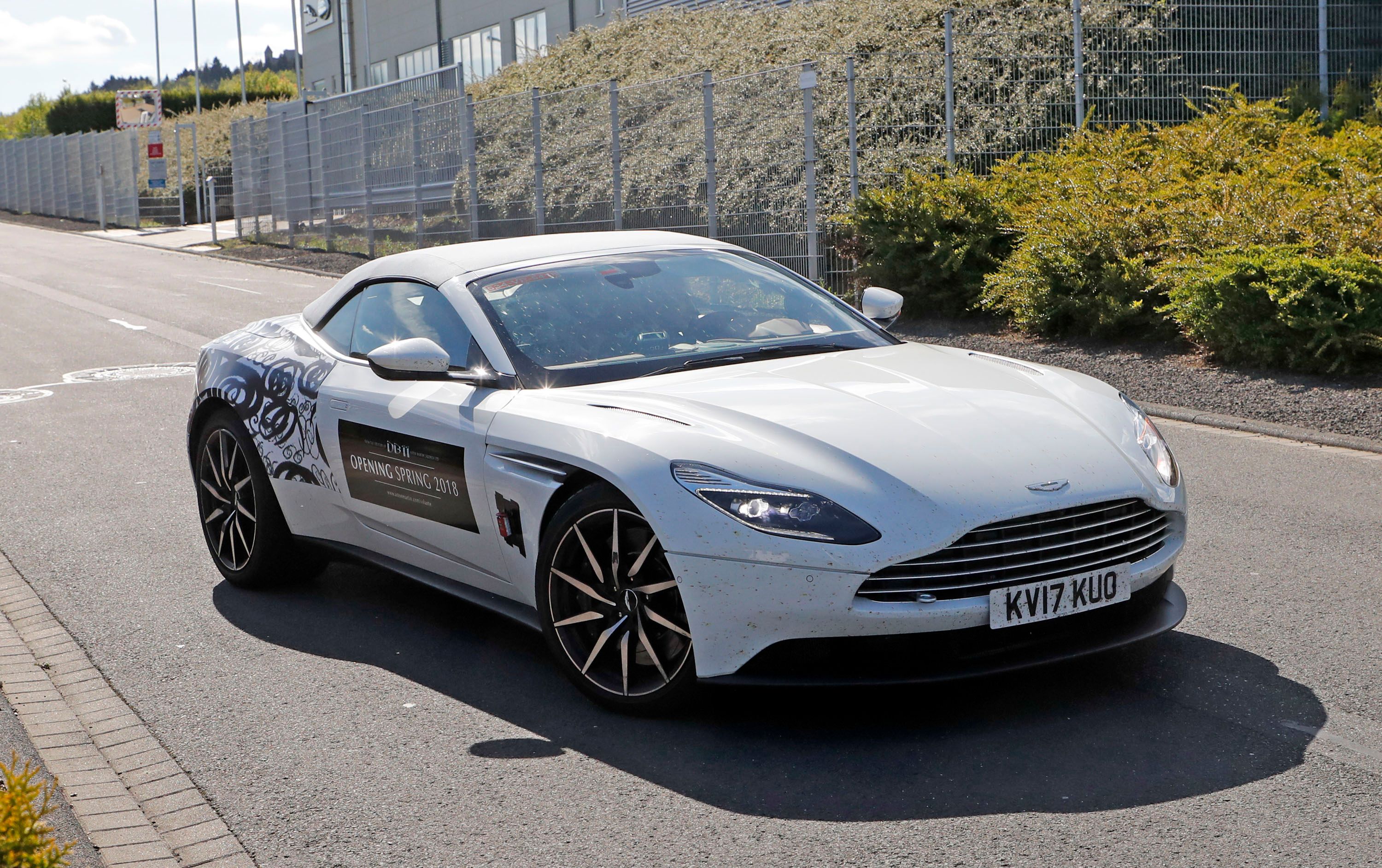
|
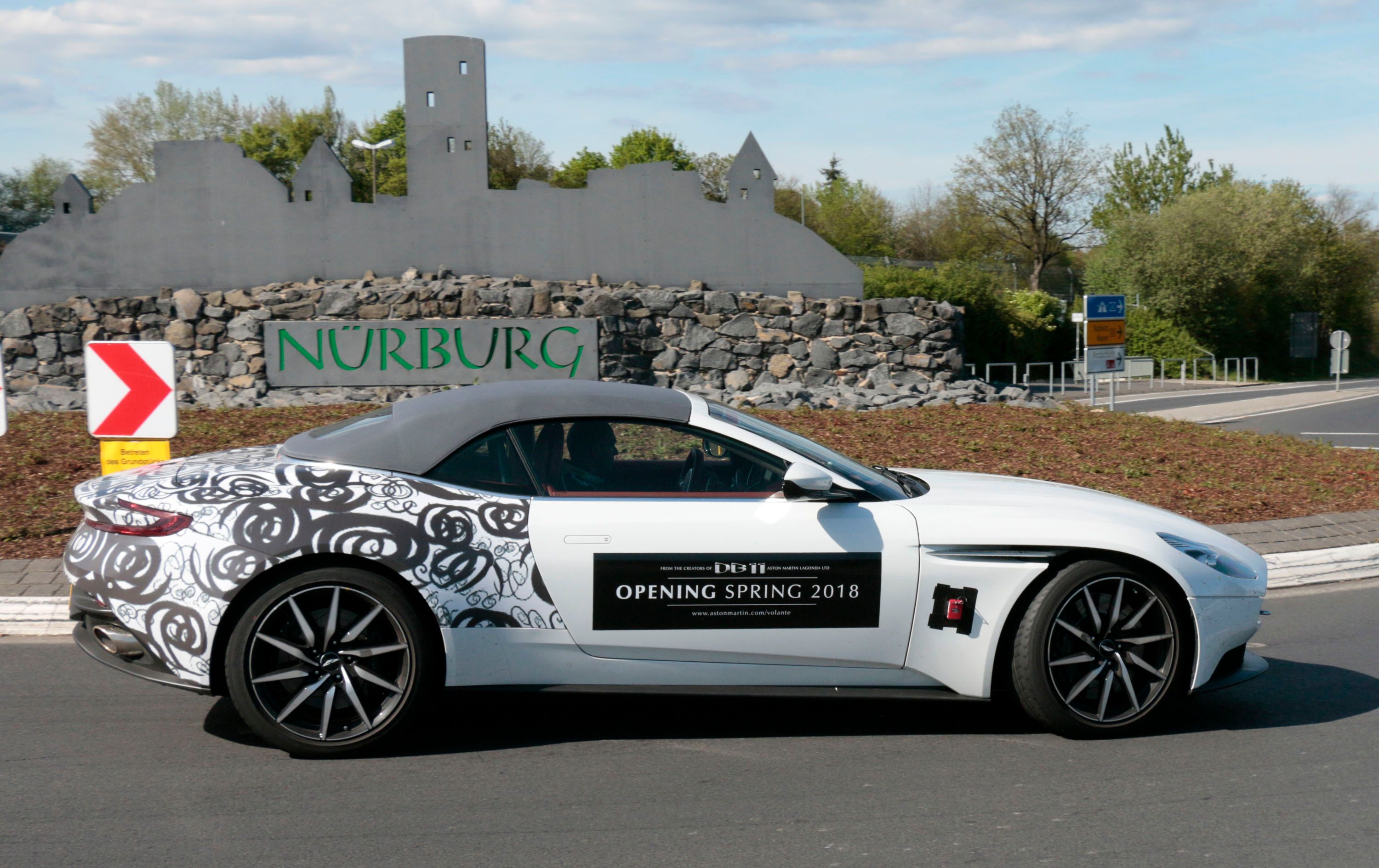
|
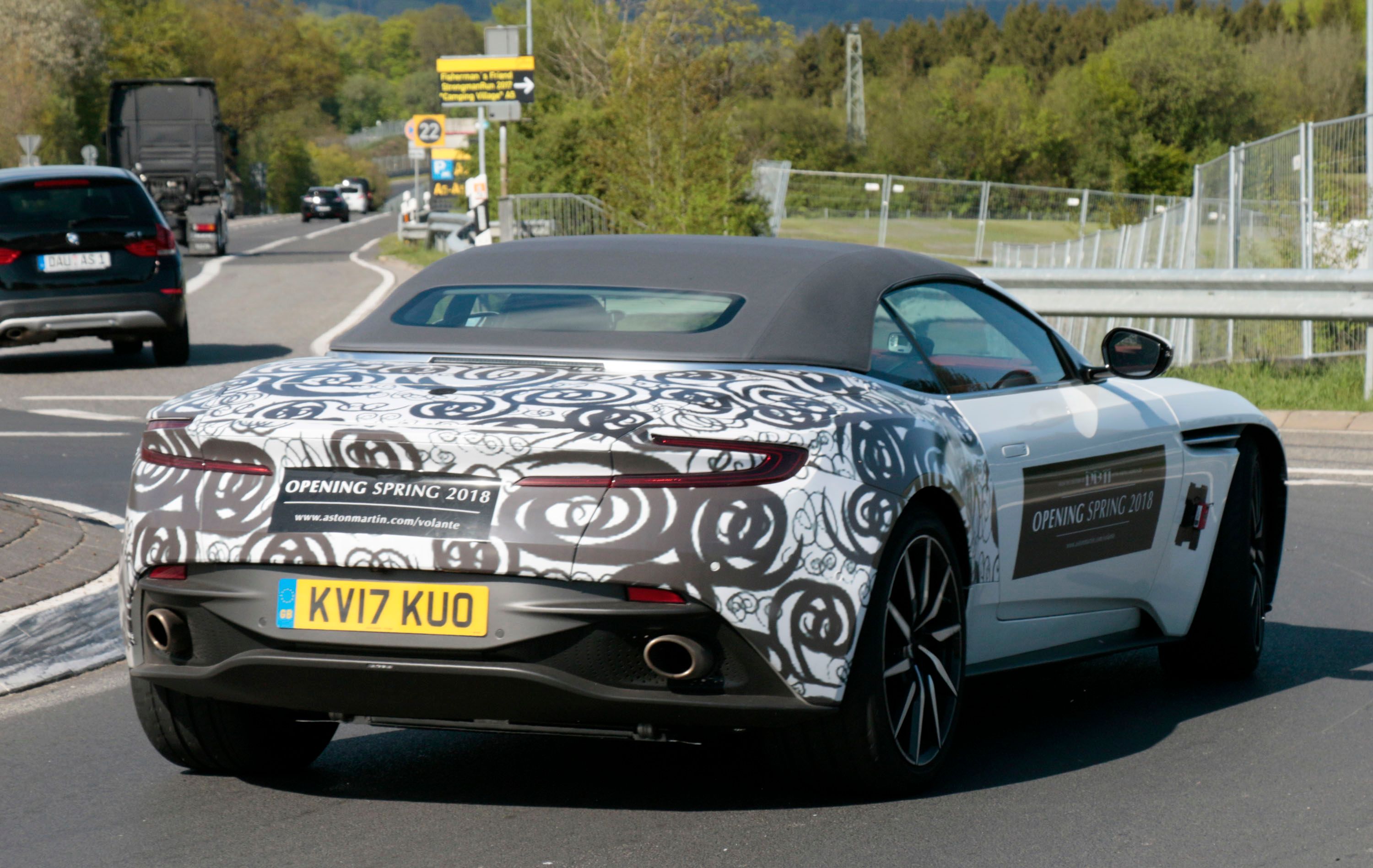
|
We last saw the Aston Martin DB11 Volante testing back in April of 2017, and just a month later, the brand’s newest droptop was caught stretching its wheels again. This time around, however, it has shed all of those fake panels that were riveted to the sides and rear, finally showing off the car’s true design. Of course, the lower portion of the side profile that we couldn’t see will be identical to that of the coupe, as will the rear haunches and rear fascia. The big difference between this model and the coupe happens above the beltline. Aston Martin was able to throw the droptop into place without altering the appearance below the beltline, but with that in mind, the rear deck is now much longer, and the canvass roof doesn’t have nearly as long of a slope to it. The rear quarter glass mimics the shape of that on the coupe but is undoubtedly smaller. Chrome trim from the beltline wraps around the canvas top and traverses along the edge rear deck. Unfortunately, the convertible won’t look quite as sporty as the coupe with the top up, nor will it be as aerodynamic, but that’s a small price to pay for unlimited headroom, right?
April 5, 2017 - Aston Martin DB11 Volante caught testing at Nurbrugring
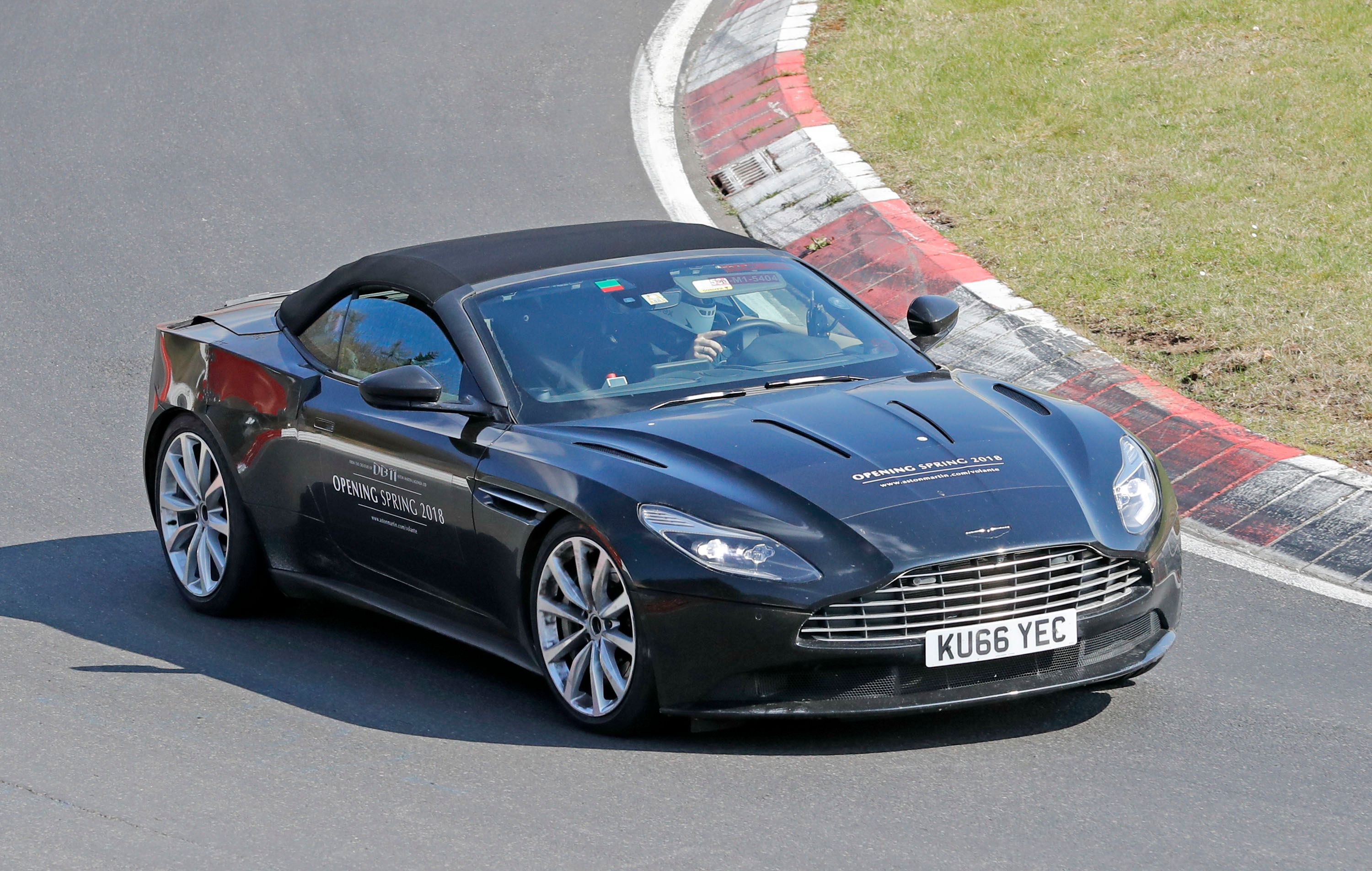
|
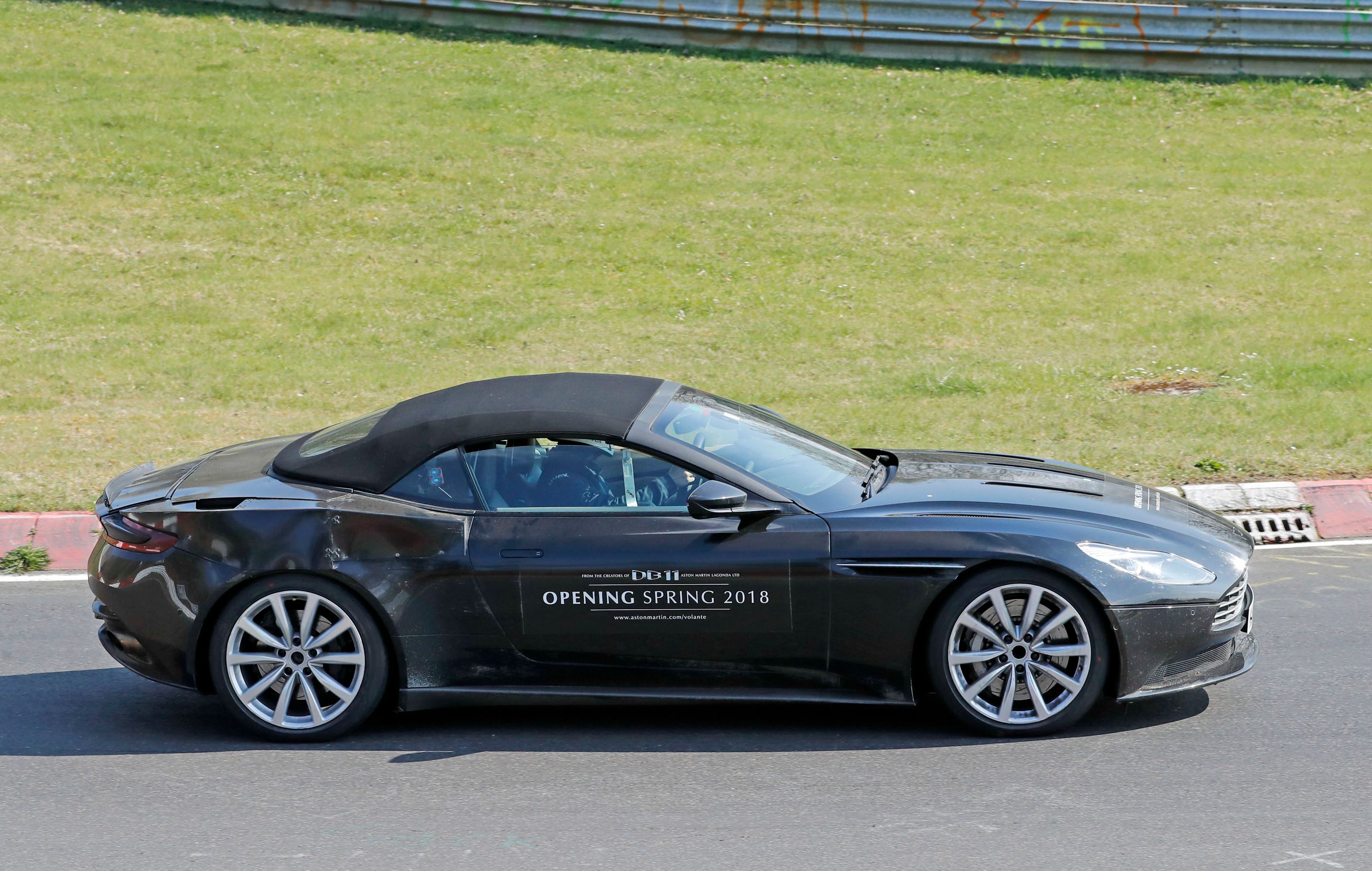
|

|
December 14, 2016 - First testing session
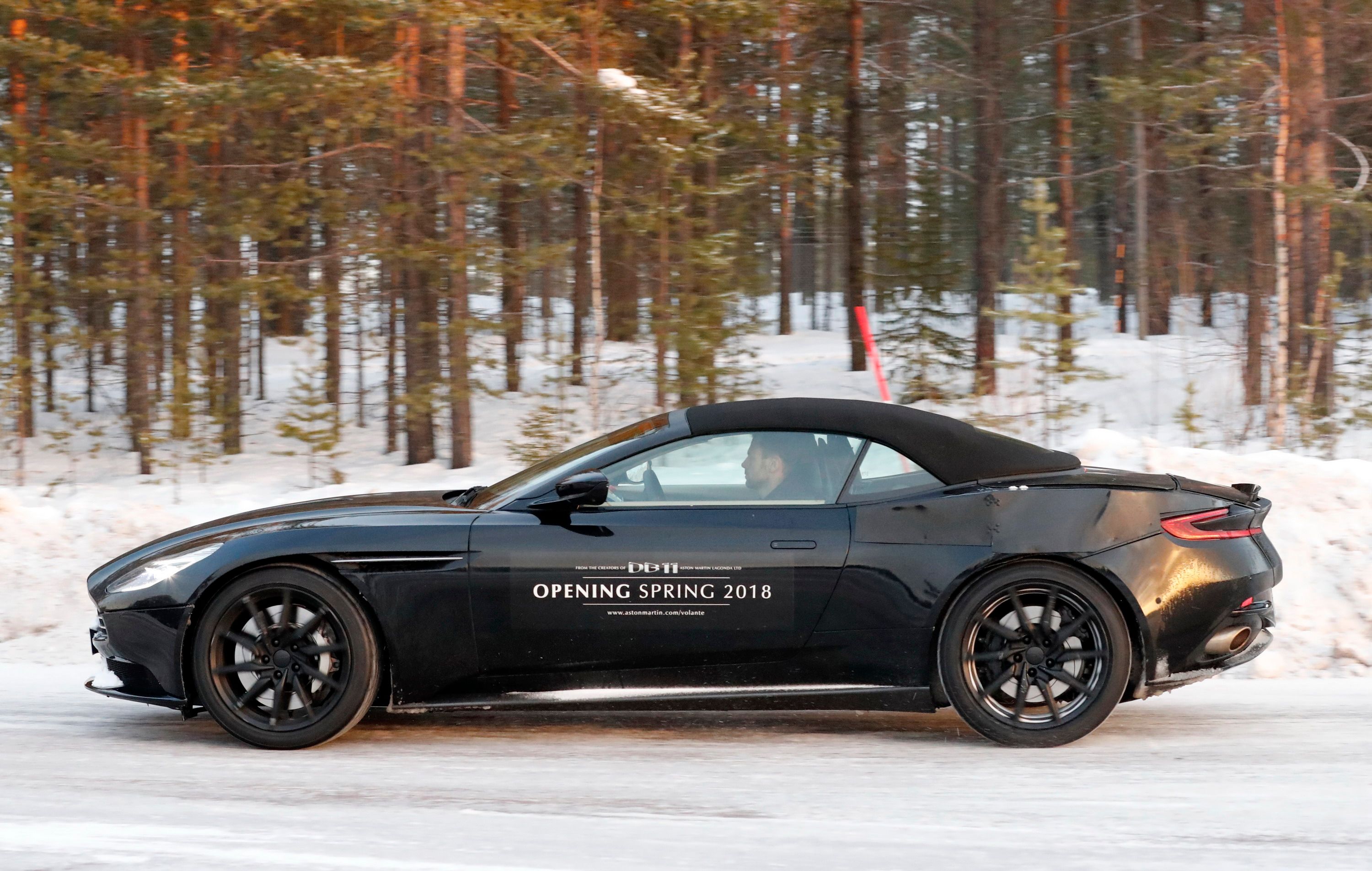
|
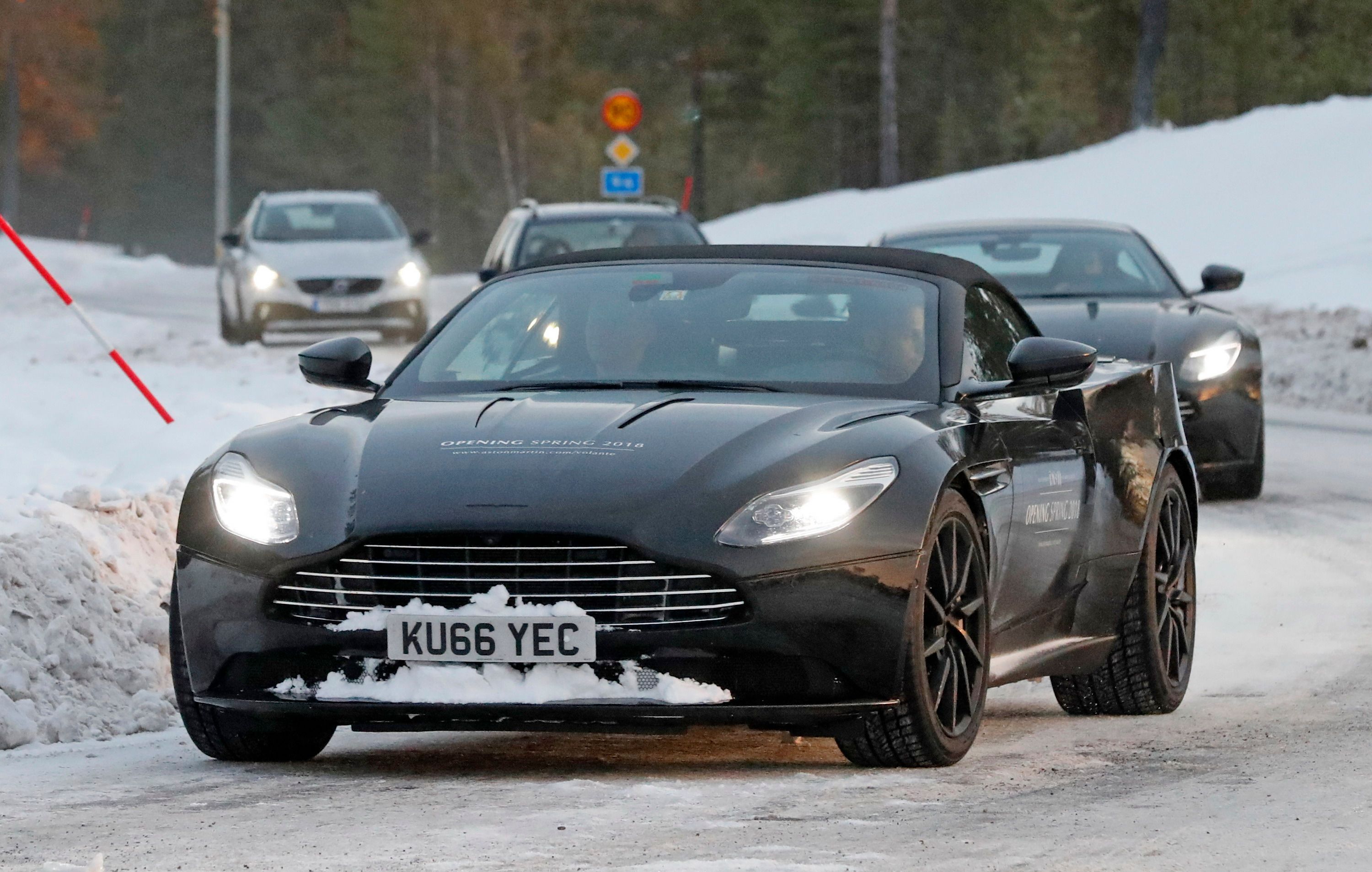
|
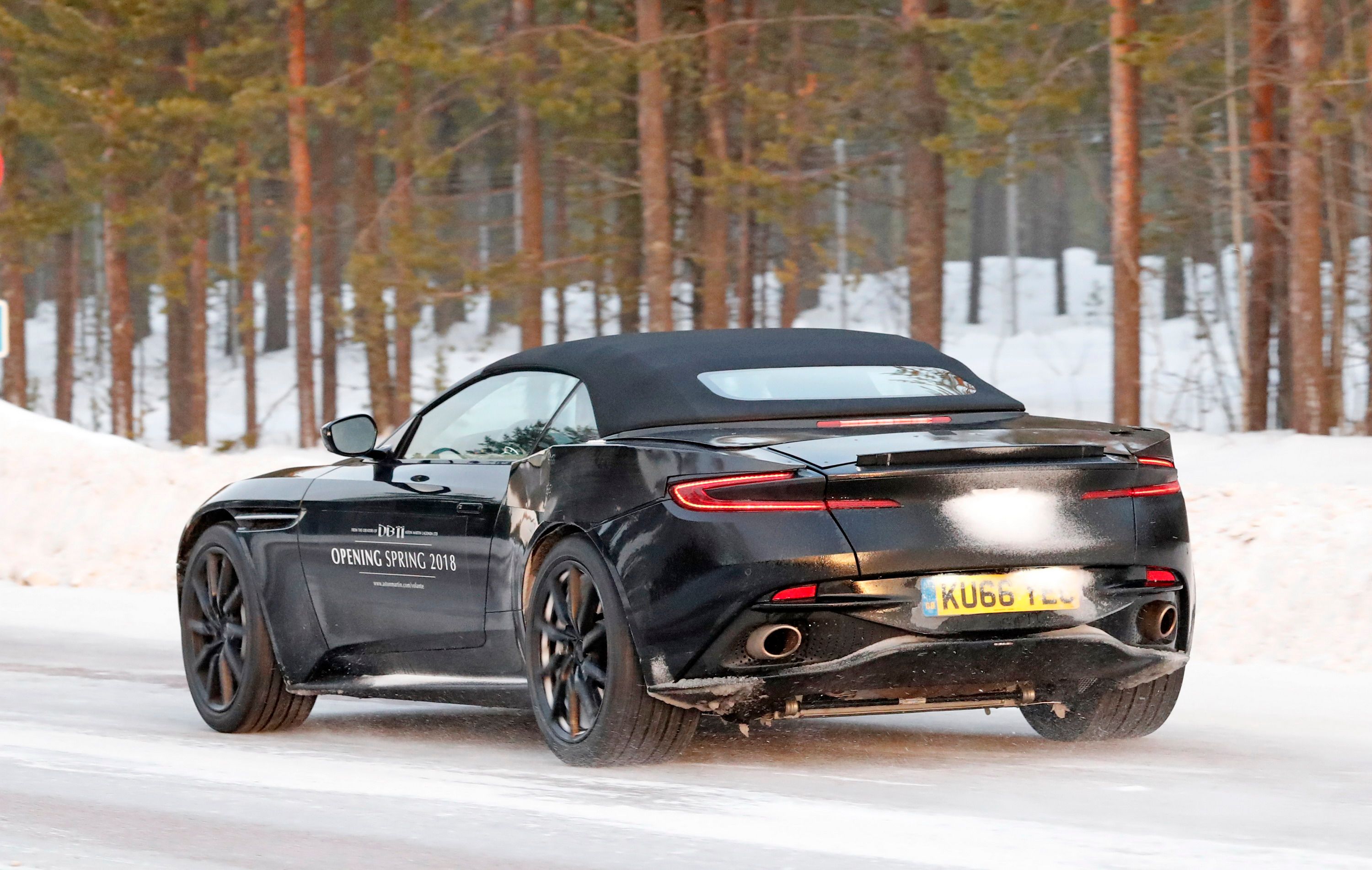
|
Prototype Vs. Rendering
|
|
ids=698327,716972 |
no_overlay=true> |
Looking at the prototype (left,) it’s clear that our rendering (right) is spot on below the waistline up front. Moving to the rear, however, we can’t make out anything about the decklid or rear quarters thanks to some cheap sheet metal. There are a few things to mention. First, we thought the storage door for the convertible top would feature two elevated pods that sit just over the headrests. This prototype doesn’t show anything like that, however. It looks more like a decklid similar to the coupe will be used but will open to the rear to allow stowage of the top. Without those pods in the rear and no dedicated door for the top, the rear decklid will likely be near identical on the outside but will be altered below the skin. As such, cargo room will be dramatically cut in half, but the important part is that the Volante will look a lot like the coupe in the rear, despite being a convertible.
Update History
Updated 04/05/2017: Our spy photographers caught the upcoming Aston Martin DB11 Volante lapping around the famous Nurburgring track.


